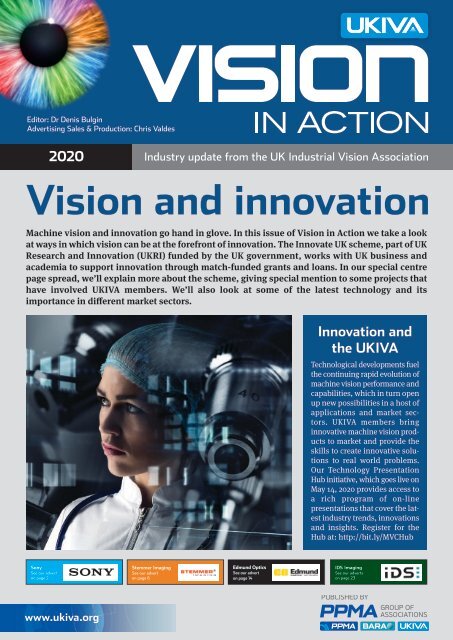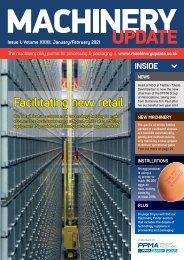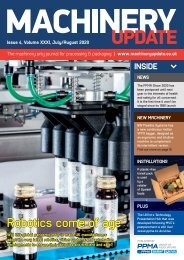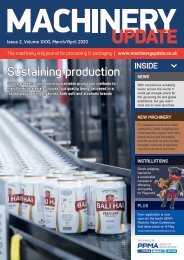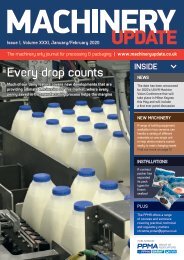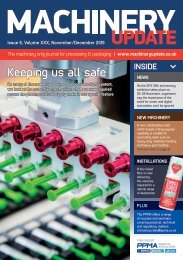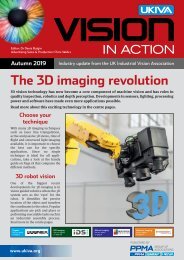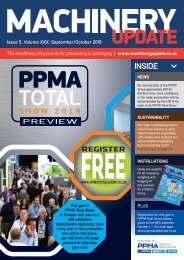Vision in Action 2020
- No tags were found...
Create successful ePaper yourself
Turn your PDF publications into a flip-book with our unique Google optimized e-Paper software.
Editor: Dr Denis Bulg<strong>in</strong><br />
Advertis<strong>in</strong>g Sales & Production: Chris Valdes<br />
<strong>2020</strong><br />
Industry update from the UK Industrial <strong>Vision</strong> Association<br />
<strong>Vision</strong> and <strong>in</strong>novation<br />
Mach<strong>in</strong>e vision and <strong>in</strong>novation go hand <strong>in</strong> glove. In this issue of <strong>Vision</strong> <strong>in</strong> <strong>Action</strong> we take a look<br />
at ways <strong>in</strong> which vision can be at the forefront of <strong>in</strong>novation. The Innovate UK scheme, part of UK<br />
Research and Innovation (UKRI) funded by the UK government, works with UK bus<strong>in</strong>ess and<br />
academia to support <strong>in</strong>novation through match-funded grants and loans. In our special centre<br />
page spread, we’ll expla<strong>in</strong> more about the scheme, giv<strong>in</strong>g special mention to some projects that<br />
have <strong>in</strong>volved UKIVA members. We’ll also look at some of the latest technology and its<br />
importance <strong>in</strong> different market sectors.<br />
Innovation and<br />
the UKIVA<br />
Technological developments fuel<br />
the cont<strong>in</strong>u<strong>in</strong>g rapid evolution of<br />
mach<strong>in</strong>e vision performance and<br />
capabilities, which <strong>in</strong> turn open<br />
up new possibilities <strong>in</strong> a host of<br />
applications and market sectors.<br />
UKIVA members br<strong>in</strong>g<br />
<strong>in</strong>novative mach<strong>in</strong>e vision products<br />
to market and provide the<br />
skills to create <strong>in</strong>novative solutions<br />
to real world problems.<br />
Our Technology Presentation<br />
Hub <strong>in</strong>itiative, which goes live on<br />
May 14, <strong>2020</strong> provides access to<br />
a rich program of on-l<strong>in</strong>e<br />
presentations that cover the latest<br />
<strong>in</strong>dustry trends, <strong>in</strong>novations<br />
and <strong>in</strong>sights. Register for the<br />
Hub at: http://bit.ly/MVCHub<br />
Sony<br />
See our advert<br />
on page 2<br />
Stemmer Imag<strong>in</strong>g<br />
See our advert<br />
on page 6<br />
Edmund Optics<br />
See our advert<br />
on page 14<br />
IDS Imag<strong>in</strong>g<br />
See our adverts<br />
on page 23<br />
www.ukiva.org
3<br />
FOREWORD by Allan Anderson<br />
CONTENTS<br />
The coronavirus 2 (COVID-19) pandemic has led to<br />
the cancellation of several <strong>Vision</strong> events globally,<br />
<strong>in</strong>clud<strong>in</strong>g our own Mach<strong>in</strong>e <strong>Vision</strong> Conference<br />
and Exhibition. However while we wait for the next<br />
MVC <strong>in</strong> Spr<strong>in</strong>g 2021, a FREE-to-access Technology<br />
Presentation Hub will go live at www.mach<strong>in</strong>evisionconference.co.uk from<br />
May 14, <strong>2020</strong> to showcase content that would have been presented at the<br />
orig<strong>in</strong>al event. More details are available on Page 5.<br />
However, bus<strong>in</strong>ess must cont<strong>in</strong>ue, especially now that the UK has left the<br />
EU. Some early <strong>in</strong>dicators could be very positive for the UK vision <strong>in</strong>dustry. For<br />
example, the government is encourag<strong>in</strong>g employers to develop automation<br />
technology and <strong>in</strong>vest <strong>in</strong> reta<strong>in</strong><strong>in</strong>g staff as a consequence of its proposed new<br />
immigration policy. By restrict<strong>in</strong>g the issue of visas to low-skilled workers, less<br />
low cost labour will be available. Mach<strong>in</strong>e vision can make a massive<br />
contribution to the automation of many <strong>in</strong>dustrial processes, although the UK’s<br />
current track record on automation is not good.<br />
In 2018, the UK was ranked 22nd <strong>in</strong> the world for the number of <strong>in</strong>dustrial<br />
robots <strong>in</strong>stalled per 10,000 employees <strong>in</strong> manufactur<strong>in</strong>g <strong>in</strong>dustry. A 2019 report<br />
from the House of Commons Bus<strong>in</strong>ess, Energy and Industrial Strategy Select<br />
Committee, observed: “The UK’s low automation adoption is part of our<br />
lagg<strong>in</strong>g productivity, especially for SMEs, which is prevent<strong>in</strong>g a much-needed<br />
rise <strong>in</strong> economic growth, wages and liv<strong>in</strong>g standards.” It goes on to say: “Where<br />
we have a new chance to lead and succeed is with service robotics and <strong>in</strong> AI,<br />
but only if we are support<strong>in</strong>g British bus<strong>in</strong>esses and researchers to <strong>in</strong>novate.”<br />
We take a good look at <strong>in</strong>novation <strong>in</strong> vision <strong>in</strong> this issue of <strong>Vision</strong> <strong>in</strong> <strong>Action</strong>.<br />
While the vast range of proven mach<strong>in</strong>e vision technology available could help<br />
with automation across numerous <strong>in</strong>dustrial sectors, <strong>in</strong>novation is key for<br />
further <strong>in</strong>creases <strong>in</strong> productivity.<br />
Allan Anderson, UKIVA Chairman<br />
Application Articles .................. 4-12<br />
Embrac<strong>in</strong>g <strong>in</strong>novation............... 15-18<br />
Product Updates ..................... 21-29<br />
UKIVA Directory ......................... 30<br />
Events, Tra<strong>in</strong><strong>in</strong>g, Technical Tips .....30<br />
Free subscription contact<br />
Christ<strong>in</strong>e Valdes<br />
T: +44 (0) 20 8773 5517<br />
E: chris.valdes@ppma.co.uk<br />
We are always look<strong>in</strong>g to improve<br />
<strong>Vision</strong> <strong>in</strong> <strong>Action</strong>, for comments and<br />
feedback please email the editor<br />
Denis Bulg<strong>in</strong>, Technical Market<strong>in</strong>g Services<br />
E: denis@technicalmarket<strong>in</strong>gservices.co.uk<br />
Design and Artwork: Barry Heath<br />
E: bmh@bt<strong>in</strong>ternet.com<br />
www.ukiva.org
4<br />
ASSOCIATION NEWS<br />
APPLICATION ARTICLES<br />
SCORPION VISION WINS 2019<br />
PPMA VISION AWARD<br />
Scorpion <strong>Vision</strong> won the 2019 PPMA 'Innovative<br />
Mach<strong>in</strong>e <strong>Vision</strong> Project' award for the development<br />
of a 3D robotic solution for the application of labels<br />
to wedges of Blue Stilton cheese at the Long<br />
Clawson Dairy <strong>in</strong> Melton Mowbray. This was to<br />
overcome haphazard labell<strong>in</strong>g by the exist<strong>in</strong>g<br />
z3D Cheese wedge <strong>in</strong>spection<br />
mechanical labell<strong>in</strong>g system caused by variations<br />
<strong>in</strong> the size, shape and wedge angle of each wedge of<br />
cheese. Scorpion <strong>Vision</strong> worked with robot<br />
<strong>in</strong>tegrator, Stelram Eng<strong>in</strong>eer<strong>in</strong>g, to <strong>in</strong>stall two end<br />
of l<strong>in</strong>e robotic labell<strong>in</strong>g systems that use 3D vision<br />
to create a 3D model of each cheese. This is then<br />
used to def<strong>in</strong>e the wedge height, angle and<br />
direction and the label placement coord<strong>in</strong>ates are<br />
then sent to the robot. The label is applied with +/-<br />
2mm accuracy <strong>in</strong> the X/Y location <strong>in</strong> the centre of<br />
the wedge and is also applied straight. This solution<br />
has <strong>in</strong>creased throughput by 100% for each l<strong>in</strong>e.<br />
UKIVA MEMBERSHIP<br />
CONTINUES TO GROW<br />
The UKIVA membership has grown once more as<br />
we welcome Beckhoff Automation Ltd, Edmund<br />
Optics Ltd, OEM Automatic Ltd, Spookfish<br />
Innovations Ltd and Tendr<strong>in</strong>g Pacific Ltd. Beckhoff<br />
Automation is a world leader <strong>in</strong> PC-based control<br />
systems, <strong>in</strong>corporat<strong>in</strong>g vision <strong>in</strong>to many<br />
applications. Edmund Optics is a premier provider<br />
Editorial material <strong>in</strong> this section is provided by UKIVA Members.<br />
Content accuracy is the responsibility of <strong>in</strong>dividual UKIVA Members.<br />
ALLIED VISION<br />
www.alliedvision.com<br />
Visual <strong>in</strong>spection on hard disk drive cases<br />
As hard disk drive (HDD) manufacturers cont<strong>in</strong>ue to <strong>in</strong>crease production to meet the<br />
ever-<strong>in</strong>creas<strong>in</strong>g demand for digital storage, quality control has become even more vital.<br />
It is crucial for a HDD to be perfectly fitted and sealed <strong>in</strong> its case for efficient mechanical<br />
operation and protection from external environmental effects.<br />
Manufacturers of HDD cases have to make sure that there are no defects or<br />
<strong>in</strong>complete mach<strong>in</strong><strong>in</strong>g on HDD cases’ thread holes. Flexon Technology, a system<br />
<strong>in</strong>tegrator located <strong>in</strong> Thailand, has developed Visual Mach<strong>in</strong>e Inspection (VMI) for the<br />
production l<strong>in</strong>e, to <strong>in</strong>crease the productivity and accuracy of HDD case quality control<br />
<strong>in</strong>spection. The <strong>in</strong>spection is performed on the top, side and back of the case us<strong>in</strong>g<br />
Allied <strong>Vision</strong>’s Mako G-125B PoE and Manta G-505 PoE GigE mach<strong>in</strong>e vision cameras,<br />
featur<strong>in</strong>g Sony CCD sensors.<br />
There are 2 vision stations <strong>in</strong> each VMI mach<strong>in</strong>e. The HDD cases are loaded onto the<br />
conveyor. <strong>Vision</strong> station 1 is fitted with 2 cameras. A Manta G-505B PoE camera is used<br />
to locate the position of the HDD case. A Mako G-125B PoE camera captures 14 shots<br />
with<strong>in</strong> 4.2 seconds for defect <strong>in</strong>spection of the top part of the HDD case. The defects<br />
criteria <strong>in</strong>clude miss<strong>in</strong>g or <strong>in</strong>complete thread, thread damage, miss<strong>in</strong>g mach<strong>in</strong><strong>in</strong>g<br />
surface and miss<strong>in</strong>g drill.<br />
Once this <strong>in</strong>spection is completed, the HDD case proceeds to a flip station before it<br />
arrives at <strong>Vision</strong> 2 Station which conta<strong>in</strong>s 3 Mako G-125B PoE cameras and 1 Manta<br />
G-505B PoE camera. Two of the Mako cameras <strong>in</strong>spect the sides of the HDD case for<br />
miss<strong>in</strong>g or <strong>in</strong>complete thread, while the third <strong>in</strong>spects the back part of the HDD case<br />
for miss<strong>in</strong>g or <strong>in</strong>complete thread, miss<strong>in</strong>g rivet<strong>in</strong>g, miss<strong>in</strong>g drill, mach<strong>in</strong><strong>in</strong>g surface as<br />
well as part number read<strong>in</strong>g. The Manta camera locates the position of the thread hole.<br />
The cycle time <strong>in</strong> this station is 4.8 seconds. After the <strong>in</strong>spection <strong>in</strong> <strong>Vision</strong> 2 station is<br />
completed, the HDD case will proceed to the load out conveyor if all the conditions are<br />
met. If the HDD case fails the <strong>in</strong>spection it will go to the rejected pile (NG stack).<br />
of optical and imag<strong>in</strong>g components for mach<strong>in</strong>e<br />
vision applications. OEM Automatic’s mach<strong>in</strong>e<br />
vision and identification bus<strong>in</strong>ess area focuses on<br />
offer<strong>in</strong>g the full solution from lens to f<strong>in</strong>al result.<br />
Spookfish Innovations build <strong>in</strong>telligent, high-speed<br />
quality <strong>in</strong>spection solutions for the manufactur<strong>in</strong>g<br />
sector us<strong>in</strong>g the latest vision and mach<strong>in</strong>e learn<strong>in</strong>g<br />
techniques. Tendr<strong>in</strong>g Pacific’s product l<strong>in</strong>e for the<br />
packag<strong>in</strong>g <strong>in</strong>dustry <strong>in</strong>cludes end of l<strong>in</strong>e visual<br />
<strong>in</strong>spection and seal <strong>in</strong>tegrity systems.<br />
www.ukiva.org<br />
ALRAD IMAGING<br />
Flexon Visual Mach<strong>in</strong>e Inspection for HDD cases<br />
Surface OCR for tyre <strong>in</strong>spection<br />
www.alrad.co.uk<br />
Surface OCR technology from EVT is provid<strong>in</strong>g tyre manufacturers with the ability to<br />
read black pr<strong>in</strong>t such as DOT codes on the black tyre wall background. The system uses<br />
Eye<strong>Vision</strong> 3D Software and the EyeScan AT 3D sensor available from Alrad Instruments.<br />
With 100% quality <strong>in</strong>spection required for f<strong>in</strong>ished tyres, a special <strong>in</strong>tegrated surface<br />
OCR tool has been developed for use with both the standard EyeScan 3D sensor (up to<br />
2 kHz) and the high-speed EyeScan 3D sensor (from 2 kHz up to 120 kHz). The tool<br />
recognises and extracts character str<strong>in</strong>gs from surfaces us<strong>in</strong>g either scan data from the<br />
3D-height map for moulded mark<strong>in</strong>gs or 2D <strong>in</strong>tensity data for pa<strong>in</strong>ted or lasered
5<br />
APPLICATION ARTICLES<br />
ASSOCIATION NEWS<br />
MVC RESCHEDULED TO 2021<br />
As a consequence of the coronavirus 2 (COVID-19)<br />
pandemic, the <strong>2020</strong> Mach<strong>in</strong>e <strong>Vision</strong> Conference &<br />
Exhibition (MVC), has been rescheduled to Spr<strong>in</strong>g<br />
2021, with the exact date to be confirmed. Although<br />
the event was on course to be the largest <strong>in</strong> MVC’s<br />
4-year history, the well-be<strong>in</strong>g of UKIVA and event<br />
staff, exhibitors and visitors alike was of paramount<br />
importance. However, as one of the great attractions<br />
of MVC is the Conference itself, we are delighted to<br />
announce that from 14 May, <strong>2020</strong>, a Technology<br />
Presentation Hub will be free to access at the event<br />
website, www.mach<strong>in</strong>evisionconference.co.uk<br />
3D OCR<br />
mark<strong>in</strong>gs. The OCR command set offers powerful functions for the optical detection and<br />
<strong>in</strong>spection of characters. The module <strong>in</strong>cludes image pre-process<strong>in</strong>g, segment<strong>in</strong>g,<br />
sort<strong>in</strong>g and classify<strong>in</strong>g of characters.<br />
3D <strong>in</strong>spection can be used throughout the tyre manufactur<strong>in</strong>g process, <strong>in</strong>clud<strong>in</strong>g<br />
rubber extrusion profil<strong>in</strong>g, strip guidance, layer control and radial and layer runout.<br />
On completed tyres, 3D <strong>in</strong>spection applications <strong>in</strong>clude check<strong>in</strong>g for surface defects or<br />
flaws <strong>in</strong> the tyre tread and sidewall such as bulges and dents.<br />
In addition to the surface OCR tool, a surface bar code tool has also been developed.<br />
This allows1D and 2D bar codes to be read from the surface data (2D <strong>in</strong>tensity or 3D<br />
height map), without us<strong>in</strong>g an additional 2D camera or special bar code reader.<br />
MVC TECHNOLOGY<br />
PRESENTATION HUB<br />
The conference has always been designed to be<br />
educational and to appeal to visitors new to<br />
mach<strong>in</strong>e vision as well as mach<strong>in</strong>e vision experts<br />
and everybody <strong>in</strong> between. The Technology<br />
GENESI LUX<br />
Innovative light<strong>in</strong>g helps fresh fruit<br />
and seed sort<strong>in</strong>g<br />
www.genesi-elettronica.it<br />
With greater and greater demands be<strong>in</strong>g placed on the <strong>in</strong>dustrial vision systems used by<br />
manufacturers of optical sort<strong>in</strong>g mach<strong>in</strong>es, a new high power l<strong>in</strong>ear light has been<br />
developed to meet these needs. This is currently be<strong>in</strong>g used on sort<strong>in</strong>g mach<strong>in</strong>es for<br />
fresh fruit and seeds. Larger mach<strong>in</strong>ery dimensions, faster throughput of the product to<br />
be selected and new product types to be selected (aggregates, waste, plastics, organic<br />
materials etc) have all posed great challenges for the sort<strong>in</strong>g mach<strong>in</strong>e manufacturers.<br />
They need to equip their products with more efficient and reliable <strong>in</strong>dustrial vision<br />
technology <strong>in</strong> order to keep up with the competition This has led to the use of vision<br />
Presentation Hub <strong>in</strong>itiative will provide registrants<br />
with access to many of the presentations that they<br />
would have seen on the day had the event gone<br />
ahead. Anyone who had pre-registered for the<br />
orig<strong>in</strong>al event will be able to access the hub, and<br />
visitor registration will cont<strong>in</strong>ue to rema<strong>in</strong> open<br />
(http://bit.ly/MVCHub) to enable even more people<br />
to sign-up so that they do not miss out on the<br />
Conference technical content.<br />
KEYNOTE PRESENTATIONS<br />
ON THE HUB<br />
In addition to a general speaker program, the Hub<br />
will also host the two Keynote presentations that<br />
had been planned for the orig<strong>in</strong>al event. Richard<br />
Love, EMEA Market<strong>in</strong>g Manager for the NVIDIA's<br />
Jetson Embedded Processor Family, discusses<br />
‘Apply<strong>in</strong>g AI at the Edge - a <strong>Vision</strong> of the Future’.<br />
This explores how NVIDIA’s Jetson Platform, CUDA<br />
and parallel GPU acceleration can meet these ever<strong>in</strong>creas<strong>in</strong>g<br />
demands of 21st-century mach<strong>in</strong>e vision.<br />
In addition, Kieran Edge, Technical Lead for<br />
Mach<strong>in</strong>e <strong>Vision</strong> at the Advanced Manufactur<strong>in</strong>g<br />
Research Centre at the University of Sheffield,<br />
considers advances <strong>in</strong> polarisation imag<strong>in</strong>g and AI<br />
<strong>in</strong> <strong>in</strong>spection. This presentation covers how these<br />
techniques can be employed and the low cost<br />
approaches which can be used to tackle demand<strong>in</strong>g<br />
applications for high-value manufactur<strong>in</strong>g <strong>in</strong>dustry.<br />
High <strong>in</strong>tensity <strong>in</strong>cident light<strong>in</strong>g for fruit <strong>in</strong>spection<br />
cont<strong>in</strong>ued on page 7<br />
www.ukiva.org
APPLICATION ARTICLES<br />
7<br />
systems with <strong>in</strong>creas<strong>in</strong>gly higher speed and higher resolution l<strong>in</strong>e scan and area scan<br />
cameras. Different illum<strong>in</strong>ation wavelengths, <strong>in</strong>clud<strong>in</strong>g RGB, NIR and SWIR are required<br />
depend<strong>in</strong>g on the sort<strong>in</strong>g criteria to be used, such as colour, ripeness degree and<br />
humidity level, which has <strong>in</strong> turn led to the need for new, high power, multi wavelength<br />
light sources.<br />
The GEVX ultra power l<strong>in</strong>ear light is a new generation light source with a wide<br />
spectrum focus<strong>in</strong>g lens. The light operates from 350 to 1600 nm and can deliver up to 3.5<br />
million lux thanks to the 5° convergent lens. Comb<strong>in</strong>ed emissions of white/IR or RGB can<br />
be managed on a s<strong>in</strong>gle light. It is available <strong>in</strong> lengths from 4 to more than 300 cm with<br />
a self-support<strong>in</strong>g structure and can deliver high light power without need<strong>in</strong>g additional<br />
heat dissipation. The light is available <strong>in</strong> a number of versions. The normal l<strong>in</strong>ear<br />
version is used for sort<strong>in</strong>g applications on a cont<strong>in</strong>uous conveyor such as for fruit. There<br />
is also a back light version which gives a uniform l<strong>in</strong>e of 20 mm. This is ideal for<br />
applications where the items to be sorted are small and light such as seeds. These are<br />
usually viewed <strong>in</strong> silhouette by illum<strong>in</strong>at<strong>in</strong>g them from the back through a gap <strong>in</strong> the<br />
conveyor belt.<br />
IDS IMAGING DEVELOPMENT SYSTEMS GMBH<br />
www.ids-imag<strong>in</strong>g.com<br />
Avoid<strong>in</strong>g product mix-ups <strong>in</strong> the<br />
pharmaceutical <strong>in</strong>dustry<br />
Good Automated Manufactur<strong>in</strong>g Practice (GAMP) is <strong>in</strong>tended to ensure the quality of<br />
the production of pharmaceuticals, active <strong>in</strong>gredients and cosmetics. In addition,<br />
quality demands are placed on process<strong>in</strong>g, packag<strong>in</strong>g and storage and the pr<strong>in</strong>t<strong>in</strong>g and<br />
mark<strong>in</strong>g of products and packag<strong>in</strong>g must be reliably recorded and tested. This helps to<br />
prevent product mix-ups due to <strong>in</strong>correct labell<strong>in</strong>g and to ensure traceability of<br />
<strong>in</strong>gredients and end products as well as protect aga<strong>in</strong>st counterfeit<strong>in</strong>g. The German<br />
company i-mation GmbH has developed GampBOX, a plug & play image process<strong>in</strong>g<br />
system featur<strong>in</strong>g up to four robust GigE uEye FA <strong>in</strong>dustrial cameras from IDS <strong>in</strong><br />
comb<strong>in</strong>ation with HALCON image process<strong>in</strong>g software. GampBOX facilitates process<br />
optimization for pharmaceutical manufacturers as well as for suppliers (for packag<strong>in</strong>g<br />
materials, equipment) to meet the legal requirements of Directive 2011/62/EU regard<strong>in</strong>g<br />
the protection aga<strong>in</strong>st counterfeit<strong>in</strong>g of prescription-only drugs.<br />
The one-time allocation of a serial number <strong>in</strong> connection with <strong>in</strong>dividual production<br />
data (e.g. product identification GTIN, expiry date and batch number) is key to complete<br />
traceability through the entire logistics cha<strong>in</strong> from production to distribution and<br />
wholesale to the customer. The GampBOX series is divided <strong>in</strong>to three stages: the first<br />
<strong>in</strong>tegrates smart cameras <strong>in</strong>to a s<strong>in</strong>gle batch production. The second <strong>in</strong>tegrates smart<br />
cameras <strong>in</strong>to a serialised production, for example to verify a serial number <strong>in</strong> connection<br />
with <strong>in</strong>dividual production data. The third stage <strong>in</strong>tegrates up to four classic <strong>in</strong>dustrial<br />
cameras, such as the IDS GigE uEye FA camera, <strong>in</strong>to a PC-supported system with<br />
database synchronisation (for GS1 and ePedigree) <strong>in</strong> a serialised production. The<br />
GampBOX takes full control of the cameras and provides an OPC UA <strong>in</strong>terface for the<br />
higher-level control or the host computer to the outside. The HALCON image process<strong>in</strong>g<br />
software is responsible for implement<strong>in</strong>g the <strong>in</strong>spection task.<br />
GampBOX offers complete traceability of operat<strong>in</strong>g actions (by users with a time<br />
stamp), the creation of audit trails (for monitor<strong>in</strong>g and record<strong>in</strong>g process changes) and<br />
the safeguard<strong>in</strong>g of important process steps with electronic signatures or electronic<br />
approvals. In addition, recipe management and version<strong>in</strong>g, archiv<strong>in</strong>g of user actions<br />
subject to verification of a serial number <strong>in</strong> connection with <strong>in</strong>dividual production data<br />
are possible.<br />
Save the date!<br />
i-mation GampBOX<br />
10 – 12 November <strong>2020</strong><br />
Messe Stuttgart, Germany<br />
www.vision-fair.de<br />
www.ukiva.org
8<br />
APPLICATION ARTICLES<br />
cv-x2<br />
KEYENCE<br />
www.keyence.co.uk<br />
<strong>Vision</strong> <strong>in</strong>spection for organic biscuit quality control<br />
Nutrition & Santé is Europe’s lead<strong>in</strong>g maker of organic and health foods. Biscuits roll off<br />
its production l<strong>in</strong>es <strong>in</strong> stacks of 4 or 5 units that are then wrapped <strong>in</strong> packs and <strong>in</strong>serted<br />
<strong>in</strong> their cardboard packag<strong>in</strong>g at high speed. It is essential to avoid broken biscuits <strong>in</strong> a<br />
stack s<strong>in</strong>ce they not only have an adverse effect on customers’ perception of the quality<br />
of the products, there is also a risk of packs be<strong>in</strong>g <strong>in</strong>correctly sealed due to bits of biscuit<br />
gett<strong>in</strong>g <strong>in</strong> the way. Biscuit <strong>in</strong>spection is challeng<strong>in</strong>g due to the high speeds required and<br />
the variety of biscuit sizes and shapes conveyed on each l<strong>in</strong>e at Nutrition & Santé’s<br />
production site <strong>in</strong> Annonay, France. The huge quantities of biscuits that are processed<br />
each m<strong>in</strong>ute mean that there is a w<strong>in</strong>dow of just 150 ms for <strong>in</strong>spect<strong>in</strong>g each stack. The<br />
Keyence CV-X400 vision series was able to deliver the detection speed required for this<br />
demand<strong>in</strong>g application. The system checks for broken biscuits us<strong>in</strong>g edge detection on<br />
images from two cameras placed around 20 centimetres above the biscuits on each l<strong>in</strong>e.<br />
A different program is set for each of the thirty plus variants of biscuit shape and size<br />
that need to be <strong>in</strong>spected on each l<strong>in</strong>e.<br />
Edge detection is just one of the 28 core <strong>in</strong>spection tools available with CV-X400<br />
vision series. Each tool makes it possible to set up a detection application both simply<br />
and quickly, even for the eng<strong>in</strong>eers at Nutrition & Santé who did not have any previous<br />
experience <strong>in</strong> vision <strong>in</strong>spection. The CV-X400 Series features 7 core processors<br />
supplemented by 7 core DSPs, designed specifically for image process<strong>in</strong>g. These<br />
fourteen processors are used to achieve parallel process<strong>in</strong>g and atta<strong>in</strong> the fastest<br />
process<strong>in</strong>g speed possible. The ability of the system to process 2 million pixels <strong>in</strong> 11.7 ms<br />
means that the vision system works faster than the production l<strong>in</strong>es, thus provid<strong>in</strong>g<br />
headroom for future developments. The process<strong>in</strong>g power also makes it possible to<br />
perform multiple <strong>in</strong>spections and further enhance the reliability of <strong>in</strong>-process<br />
<strong>in</strong>spections thanks to its excellent repeatability and many image-process<strong>in</strong>g tasks that<br />
optimise <strong>in</strong>spection accuracy. The system runs seven days a week and provides the<br />
detection reliability and stability needed by the customer.<br />
Want to learn more about 3D?<br />
Download our Guide to<br />
3D Imag<strong>in</strong>g Techniques<br />
www.clearviewimag<strong>in</strong>g.co.uk/3d<br />
www.ukiva.org
Top Performance <strong>in</strong> 1D, 2D and 3D<br />
B<strong>in</strong> Pick<strong>in</strong>g<br />
Large b<strong>in</strong>s such as Euro pallets are recorded<br />
along with their content as a 3D po<strong>in</strong>t cloud.<br />
Even extremely small objects <strong>in</strong> large conta<strong>in</strong>ers<br />
can be reliably detected <strong>in</strong> this way.<br />
Quality Assurance for PCBs<br />
wenglor’s <strong>Vision</strong>System2D is an image process<strong>in</strong>g<br />
system which has been developed for<br />
simple as well as complex vision applications.<br />
It consists of up to 16 digital cameras for image<br />
record<strong>in</strong>g, <strong>in</strong>terchangeable lenses with various<br />
focal distances, external illum<strong>in</strong>ation components<br />
for ideal light<strong>in</strong>g and a control unit (IPC)<br />
for image evaluation.<br />
Gap and Flushness Measurement of<br />
Transparent Objects<br />
Gap and fl ushness accuracy for auto body<br />
parts such as doors, tailgates and headlights<br />
is an important quality criterion <strong>in</strong> the automotive<br />
<strong>in</strong>dustry. Thanks to the weCat3D model<br />
variant with UV light, gap dimensions can be<br />
reliably detected for matte and glossy, as well<br />
as transparent materials such as metal, glass<br />
and plastic.<br />
wenglor sensoric ltd.<br />
Unit 2, Beechwood | Cherry Hall Road, Ketter<strong>in</strong>g Bus<strong>in</strong>ess Park<br />
Ketter<strong>in</strong>g, Northants NN14 1UE | Tel. +44 (0)1536 313580<br />
<strong>in</strong>fo.uk@wenglor.com | www.wenglor.com/visionworld
10<br />
The new Alvium 1800 Series<br />
BUY NOW!<br />
alliedvision.com/reth<strong>in</strong>k<br />
// ALVIUM 1800 USB3 VISION CAMERA<br />
Reth<strong>in</strong>k embedded vision<br />
The revolutionary Alvium 1800 camera series meets all the standards of<br />
an <strong>in</strong>dustrial camera. But also builds on an <strong>in</strong>novative, embedded-optimized<br />
platform for small size, low power consumption and affordability.<br />
Discover the unique benefits of our crossover camera on<br />
alliedvision.com/reth<strong>in</strong>k<br />
powered by
APPLICATION ARTICLES<br />
11<br />
METTLER TOLEDO<br />
www.mt.com<br />
<strong>Vision</strong> system aids food product traceability<br />
and label verification<br />
Crofter’s Foods is a leader <strong>in</strong> the organic and all natural food <strong>in</strong>dustries, provid<strong>in</strong>g fruit<br />
spreads, conserves, jellies and jams made from natural <strong>in</strong>gredients. In addition to<br />
manufactur<strong>in</strong>g its own brand product l<strong>in</strong>es it has a number of private-label customers.<br />
Crofter’s uses a Mettler Toledo CI-<strong>Vision</strong> <strong>in</strong>spection system at its manufactur<strong>in</strong>g plant <strong>in</strong><br />
Segu<strong>in</strong>, Ontario, Canada, for advanced label verification. This ensures every product<br />
package meets their specifications and offers their customers advanced track<strong>in</strong>g<br />
<strong>in</strong>formation.<br />
The facility can package up to 150,000 jars of product per shift. Unique product and<br />
lot <strong>in</strong>formation is encoded <strong>in</strong> a QR code that is pr<strong>in</strong>ted on every label to meet the very<br />
strict requirements for food safety and traceability required by many retailers throughout<br />
North America. This code can be scanned us<strong>in</strong>g a smartphone to direct users to Crofter’s<br />
web page to check out batch and useful product <strong>in</strong>formation for that jar. The CI-<strong>Vision</strong><br />
system verifies the readability of the QR codes, and <strong>in</strong>spects every label applied to ensure<br />
it matches the requirements for that product. Installed on the plant’s rotary 16-station<br />
<strong>in</strong>l<strong>in</strong>e labeler, the vision <strong>in</strong>spection system uses three cameras to execute various quality<br />
control checks on all labels after the QR code has been laser pr<strong>in</strong>ted. It can detect miss<strong>in</strong>g,<br />
twisted and damaged labels, verify the UPC code, identify the shape of the jar, confirm<br />
the colour of the product and check that the cap code has been properly applied <strong>in</strong> full.<br />
It can also be programmed for any new label designs or for other <strong>in</strong>spections as required.<br />
The system differentiates between the similar look<strong>in</strong>g Bil<strong>in</strong>gual Canadian product<br />
labels and U.S. bound English-only labels to ensure that these are not mixed up to avoid<br />
a costly product recall. It can be ‘future proofed’ by add<strong>in</strong>g up to 3 more cameras to add<br />
critical control po<strong>in</strong>ts upstream and/or downstream on the l<strong>in</strong>e as requirements evolve.<br />
These are all managed from a s<strong>in</strong>gle HMI (human-mach<strong>in</strong>e <strong>in</strong>terface) term<strong>in</strong>al. The<br />
vision system can be <strong>in</strong>tegrated with Mettler Toledo’s own ProdX data collection system,<br />
so that the plant management can have real-time access to what is happen<strong>in</strong>g on the<br />
l<strong>in</strong>e. Mettler Toledo has also <strong>in</strong>stalled a checkweigher and Safel<strong>in</strong>e metal detection<br />
system at the plant. (Orig<strong>in</strong>al article published <strong>in</strong> Canadian Packag<strong>in</strong>g).<br />
SCORPION VISION<br />
Ic<strong>in</strong>g g<strong>in</strong>gerbread biscuits<br />
www.scorpionvision.co.uk<br />
The Scorpion <strong>Vision</strong> 3D ic<strong>in</strong>g robot system enables a robot with a biscuit ic<strong>in</strong>g depositor<br />
to accurately apply ic<strong>in</strong>g to a tray of handmade biscuits, thanks to very localised 3D<br />
profil<strong>in</strong>g of each biscuit. The distance between the depositor and the surface of the<br />
biscuit is ma<strong>in</strong>ta<strong>in</strong>ed to sub millimetre accuracy. The system uses a Scorpion 3D St<strong>in</strong>ger<br />
with 2 x 2.3 Mpixel cameras, <strong>in</strong>tegrated illum<strong>in</strong>ation and a random pattern projector.<br />
A 12 mm IR lens is used and software runs on an embedded <strong>in</strong>dustrial PC.<br />
Up to 32 biscuits are placed on a tray for ic<strong>in</strong>g by the robot. The tray is moved to the<br />
<strong>in</strong>spection area by a conveyor and clamped <strong>in</strong> place under the 3D camera. An image is<br />
captured <strong>in</strong> 200 ms, blend<strong>in</strong>g laser and LED illum<strong>in</strong>ation. The 2 cameras <strong>in</strong>side Scorpion<br />
3D St<strong>in</strong>ger create a basel<strong>in</strong>e of 200 mm offer<strong>in</strong>g a good disparity for the work<strong>in</strong>g area.<br />
The robot has a nom<strong>in</strong>al draw<strong>in</strong>g model <strong>in</strong> its memory for each biscuit that def<strong>in</strong>es the<br />
path pattern of the ic<strong>in</strong>g. There are 12 pre-tra<strong>in</strong>ed models and new ones can be tra<strong>in</strong>ed.<br />
The robot receives measurements from the vision system, scal<strong>in</strong>g its predef<strong>in</strong>ed model<br />
up or down and start<strong>in</strong>g ic<strong>in</strong>g from the reference po<strong>in</strong>t.<br />
The cameras were calibrated at the conveyor belt on a flat surface, but the trays used<br />
are not flat. Even when clamped at their four corners, the surface on which the biscuits<br />
lay is still bowed, so the portion of the tray around each biscuit is found and the plane<br />
used to extract a heightmap for each biscuit. The images created <strong>in</strong> this way have the<br />
correct dimensions regardless of whether the tray is bowed. The vision system can then<br />
measure the biscuit height, width and length and send it to the robot.<br />
The result is massive cost sav<strong>in</strong>gs and <strong>in</strong>creased throughput for the bakery, as the<br />
production can be dramatically <strong>in</strong>creased without add<strong>in</strong>g more labour costs. The<br />
Scorpion <strong>Vision</strong> 3D ic<strong>in</strong>g robot system can be used for any bakery product, <strong>in</strong>clud<strong>in</strong>g<br />
birthday cakes where the top of the cake is a dome shape.<br />
CI-<strong>Vision</strong> <strong>in</strong>spection system at Crofter's Foods<br />
(courtesy Canadian Packag<strong>in</strong>g)<br />
3D image of g<strong>in</strong>gerbread biscuits<br />
www.ukiva.org
12<br />
APPLICATION ARTICLES<br />
IMS Messesysteme X-3Dvision system<br />
ISW Smart Manual Aggregation Table<br />
www.ukiva.org<br />
SICK (UK) LTD<br />
Ranger3 Rises to A Steely Challenge<br />
www.sick.co.uk<br />
Sick Ranger3’s ability to capture dimensions, contours and surface defects make it ideal<br />
for dimension<strong>in</strong>g and <strong>in</strong>spection tasks <strong>in</strong> metal production processes. High repeatability<br />
must be assured regardless of the colour, contrast or brightness of profiles, slabs and<br />
pipes, even as they flicker with heat, and despite harsh environments contam<strong>in</strong>ated<br />
with t<strong>in</strong>der, dirt or moisture.<br />
IMS Messesysteme GmbH, who offer a range of measurement technologies for steel<br />
and non-ferrous metal production, has <strong>in</strong>tegrated the Ranger3 camera <strong>in</strong>to its optical X-<br />
3Dvision measurement system This is used for 3D <strong>in</strong>spection <strong>in</strong> thermal production<br />
processes <strong>in</strong> cont<strong>in</strong>uous cast<strong>in</strong>g plants, hot roll<strong>in</strong>g mills and tube roll<strong>in</strong>g mills. IMS’s X-<br />
3Dvision measurement system is used for 360° <strong>in</strong>spection of profiles such as H beams,<br />
C profiles, CZ profiles, sheet pil<strong>in</strong>g and tubes. To capture the entire surface seamlessly,<br />
multiple Ranger3 cameras and lasers are configured <strong>in</strong>to a s<strong>in</strong>gle, circular measurement<br />
setup. While systems usually feature between three and eight cameras, the latest plant<br />
conta<strong>in</strong>s 22 Ranger3 cameras with eight lasers <strong>in</strong> one system.<br />
Us<strong>in</strong>g the highly light-sensitive M30 CMOS sensor and ROCC (Rapid On-Chip<br />
Calculation), the Ranger 3 converts the laser l<strong>in</strong>e contour of the profile <strong>in</strong>to precise,<br />
ready-to-use 3D coord<strong>in</strong>ates. There is no need for complex post-process<strong>in</strong>g and the<br />
images are output at 4 gigabits per second via Gigabit Ethernet <strong>in</strong>terface. The camera<br />
configuration can create up to 24,000 profiles per second.<br />
Long goods or pipes are passed through the system to measure dimensions, contours<br />
and l<strong>in</strong>earity, as well the smallest of surface defects such as cracks, deposits, <strong>in</strong>clusions,<br />
or <strong>in</strong>dentations. Very small details, typically 0.3mm <strong>in</strong> the width, 0.3mm <strong>in</strong> the depth<br />
and 1mm <strong>in</strong> the length can be detected at full production speeds. Us<strong>in</strong>g Ranger3 <strong>in</strong> its<br />
X-3Dvision system, has improved dimension and contour measurement up to ± 0.1mm<br />
accuracy.<br />
STEMMER IMAGING<br />
www.stemmer-imag<strong>in</strong>g.co.uk<br />
Manual packag<strong>in</strong>g and aggregation <strong>in</strong> the<br />
pharmaceutical <strong>in</strong>dustry<br />
Pharmaceutical companies achieve significant cost sav<strong>in</strong>gs by us<strong>in</strong>g traceability and<br />
aggregation solutions as well as comply<strong>in</strong>g with regulations for proof of orig<strong>in</strong> and<br />
traceability of prescription drugs. The Smart Manual Aggregation Table (SMAT) system<br />
from ISW, Industrielle Sensorsysteme Wichmann GmbH, uses mach<strong>in</strong>e vision from<br />
Stemmer Imag<strong>in</strong>g to provide a flexible and cost-efficient solution for manual packag<strong>in</strong>g<br />
and aggregation from the fold<strong>in</strong>g box to the pallet It guides the operator through the<br />
whole process to ensure that no goods are lost dur<strong>in</strong>g the pack<strong>in</strong>g process and that the<br />
specified pack<strong>in</strong>g <strong>in</strong>formation is strictly observed.<br />
Stemmer Imag<strong>in</strong>g worked closely with ISW, provid<strong>in</strong>g expert advice on choos<strong>in</strong>g the<br />
most suitable cameras, bar lights, lenses, scanners and ID readers as well as other<br />
accessories and filter components for the vision system. They also provided <strong>in</strong>-depth<br />
support on technical issues.<br />
The stand-alone system is positioned where the delivered products require<br />
packag<strong>in</strong>g. After <strong>in</strong>itiat<strong>in</strong>g the order, the operator scans the delivered bundles of s<strong>in</strong>gleunit<br />
packages us<strong>in</strong>g a camera mounted under a glass cover. Individual package data,<br />
such as serial numbers and other identification parameters, are bundled <strong>in</strong> the<br />
database. If the record<strong>in</strong>g is correct, a label with the correspond<strong>in</strong>g serial number for the<br />
bundle is pr<strong>in</strong>ted and checked by a scanner for pr<strong>in</strong>t quality. The SMAT displays the<br />
appropriate pack<strong>in</strong>g diagram and the scanned and labelled bundles are packed <strong>in</strong>to<br />
shipp<strong>in</strong>g boxes. After fill<strong>in</strong>g up one layer of the shipp<strong>in</strong>g box, a camera mounted above<br />
captures the codes of the packed bundles. Once the whole box is filled accord<strong>in</strong>g to the<br />
pack<strong>in</strong>g diagram, the system pr<strong>in</strong>ts out a label with a s<strong>in</strong>gle code <strong>in</strong>clud<strong>in</strong>g the entire<br />
box content, l<strong>in</strong>k<strong>in</strong>g the data of each package to its box. This label is then attached to<br />
the shipp<strong>in</strong>g box and another scanner checks the validity of the code.<br />
The next stage is stack<strong>in</strong>g the completed and labelled shipp<strong>in</strong>g boxes on a pallet with<br />
SMAT provid<strong>in</strong>g similar guidance to the employee. After the pallet is loaded <strong>in</strong> this<br />
way, the labels of all cartons are recorded us<strong>in</strong>g a hand-held scanner. A third pr<strong>in</strong>ter<br />
creates another label for the entire pallet, which the employee attaches to the pallet<br />
before re-read<strong>in</strong>g it with the hand-held scanner to complete the aggregation.
RUGGED IP67 CAMERAS<br />
FOR INDUSTRIAL APPLICATIONS<br />
Designed for use across all <strong>in</strong>dustries and <strong>in</strong> harsh environments, Imperx Cheetah IP67 models feature IP67<br />
protective hous<strong>in</strong>g which allows the camera to be well-protected from solid particles <strong>in</strong>clud<strong>in</strong>g dust, dirt and sand.<br />
Our l<strong>in</strong>e of IP67 cameras also provide protection aga<strong>in</strong>st water <strong>in</strong>gress for 30 m<strong>in</strong>utes <strong>in</strong> levels up to 1 meter <strong>in</strong> depth.<br />
The cameras’ robust M12 Ethernet connectors provide <strong>in</strong>creased resistance to shock and vibration. This provides<br />
the user with long-term camera durability along with exceptional imag<strong>in</strong>g performance <strong>in</strong> harsh, demand<strong>in</strong>g <strong>in</strong>dustrial<br />
environments without the need for additional enclosures.<br />
Agricultural<br />
KEY FEATURES:<br />
Oil & Gas<br />
Automotive Manufactur<strong>in</strong>g<br />
Food & Beverage<br />
Inspection<br />
Mach<strong>in</strong>e <strong>Vision</strong><br />
Rugged Durability<br />
GEV with PoE<br />
GenICam-compliant<br />
Rugged IP67-rated M12 connectors<br />
Extreme temperature range:<br />
-40 °C to +70 °C<br />
High shock and vibe tolerance:<br />
20G (20 - 200 Hz XYZ) / 100G<br />
Lens extenders available<br />
Packag<strong>in</strong>g<br />
Pharmaceutical<br />
Process Control<br />
Traffic & Transportation<br />
www.imperx.com<br />
sales@imperx.com<br />
+1-561-989-0006<br />
LEARN MORE<br />
about Imperx IP67 Cameras<br />
https://www.imperx.com/ip67-cameras
MercuryTL Liquid Lens Telecentric Lenses<br />
Imag<strong>in</strong>g performance of a telecentric with the flexibility of<br />
a liquid lens. Allows for quick work<strong>in</strong>g distance adjustment<br />
and autofocus.<br />
Liquid Lens M12 Imag<strong>in</strong>g Lenses<br />
High resolution f/2.4 optical design with an <strong>in</strong>tegrated<br />
liquid lens. Superior image performance with quick autofocus.<br />
1.1” HPr Series Fixed Focal Length Lenses<br />
High performance ruggedized lenses that ma<strong>in</strong>ta<strong>in</strong> po<strong>in</strong>t<strong>in</strong>g<br />
stability after shock and vibration. Optimized for 1.1” sensors.<br />
Cx Series Fixed Focal Length Lenses<br />
The modular design allows for the easy <strong>in</strong>tegration of<br />
apertures, filters or liquid lenses. Get performance & flexibility.<br />
F<strong>in</strong>d out more at:<br />
www.edmundoptics.co.uk<br />
Don’t miss the<br />
MVC virtual<br />
presentation by Boris<br />
Lange on May 14 th<br />
www.<br />
mach<strong>in</strong>evisionconference<br />
.co.uk<br />
Subscribe to our Newsletter Today!<br />
Stay <strong>in</strong>formed about <strong>in</strong>dustry trends, events, web<strong>in</strong>ars, and new technical resources!<br />
www.edmundoptics.co.uk/newsletter
15<br />
Embrac<strong>in</strong>g <strong>in</strong>novation<br />
The UK Government has put research and <strong>in</strong>novation at the heart of its Industrial Strategy, with the aim of<br />
mak<strong>in</strong>g the UK the most <strong>in</strong>novative country <strong>in</strong> the world and <strong>in</strong>creas<strong>in</strong>g its total R&D expenditure from<br />
1.7% of GDP <strong>in</strong> 2016 to 2.4% by 2027. Mach<strong>in</strong>e vision is a fast mov<strong>in</strong>g <strong>in</strong>novative technology, where game<br />
chang<strong>in</strong>g advances are regularly brought to market. As a well-established enabl<strong>in</strong>g technology with<br />
applications across so many <strong>in</strong>dustries, it has already contributed to many current and completed projects<br />
and will undoubtedly have significant <strong>in</strong>volvement <strong>in</strong> some of the future <strong>in</strong>novations. UK Research and<br />
Innovation (UKRI) will help the Government towards achiev<strong>in</strong>g its objectives by work<strong>in</strong>g <strong>in</strong> partnership with<br />
universities, research organisations, bus<strong>in</strong>esses, charities, and government to create the best possible<br />
environment for research and <strong>in</strong>novation to flourish. With a comb<strong>in</strong>ed budget of more than £7 billion, it<br />
br<strong>in</strong>gs together the seven Research Councils (AHRC, BBSRC, EPSRC, ESRC, MRC, NERC and STFC),<br />
Innovate UK and Research England to be <strong>in</strong>volved <strong>in</strong> projects throughout the UK. Non EU members can<br />
also participate <strong>in</strong> Horizon <strong>2020</strong>, the largest ever European fund<strong>in</strong>g programme for research and <strong>in</strong>novation.<br />
Fund<strong>in</strong>g and f<strong>in</strong>d<strong>in</strong>g vision projects<br />
Innovate UK (www.gov.uk/government/organisations/<strong>in</strong>novate-uk) funds<br />
bus<strong>in</strong>ess and research co llaborations to accelerate <strong>in</strong>novation and drive<br />
bus<strong>in</strong>ess <strong>in</strong>vestment <strong>in</strong>to research and development <strong>in</strong> a variety of ways.<br />
Through the Knowledge Transfer Partnership (KTP) scheme it l<strong>in</strong>ks<br />
bus<strong>in</strong>esses with an academic or research organisation and a graduate.<br />
It also funds a network of technology and <strong>in</strong>novation centres known as<br />
Catapults which connect bus<strong>in</strong>esses with the UK’s research and<br />
academic communities.<br />
Major <strong>in</strong>vestment<br />
S<strong>in</strong>ce 2007, Innovate UK has <strong>in</strong>vested £2.5bn, matched by £1.8bn<br />
fund<strong>in</strong>g from <strong>in</strong>dustry, across 11,000 projects. A number of these have<br />
<strong>in</strong>cluded elements of mach<strong>in</strong>e vision. At the time of writ<strong>in</strong>g, Innovate<br />
UK fund<strong>in</strong>g is available for many projects where vision could potentially<br />
play a role. These <strong>in</strong>clude:<br />
n Innovation <strong>in</strong> UK civil aerospace.<br />
n Enhancement of productivity and susta<strong>in</strong>ability of crop, livestock and<br />
aquaculture systems (UK-Canada).<br />
n Rail susta<strong>in</strong>ability, customer experience, operations or ma<strong>in</strong>tenance.<br />
n Smart and susta<strong>in</strong>able plastic packag<strong>in</strong>g<br />
n Low carbon propulsion capability <strong>in</strong> the automotive sector<br />
Key vision technologies<br />
While any vision technology could be used <strong>in</strong> an <strong>in</strong>novative project, there<br />
are a few that seem to be featur<strong>in</strong>g quite frequently.<br />
3D imag<strong>in</strong>g<br />
3D imag<strong>in</strong>g is f<strong>in</strong>d<strong>in</strong>g a lot of use <strong>in</strong> a wide variety of projects. For<br />
example <strong>in</strong> agriculture it may be necessary to dist<strong>in</strong>guish crop types from<br />
surround<strong>in</strong>g material, or identify when crops are ripe and ready for<br />
pick<strong>in</strong>g. In addition to provid<strong>in</strong>g size and shape data, the 3D system can<br />
be used to guide a robot arm for pick<strong>in</strong>g, or other actions such as<br />
selective pesticide spray<strong>in</strong>g or trimm<strong>in</strong>g.<br />
Deep learn<strong>in</strong>g<br />
Mach<strong>in</strong>e learn<strong>in</strong>g and deep learn<strong>in</strong>g methods <strong>in</strong> mach<strong>in</strong>e vision can be<br />
used <strong>in</strong> projects where there are complex classification challenges. This<br />
is particularly important for applications <strong>in</strong>volv<strong>in</strong>g organic items such as<br />
fruit and vegetables, but could readily be deployed <strong>in</strong> almost any <strong>in</strong>dustry<br />
<strong>in</strong>clud<strong>in</strong>g automotive, aerospace, agriculture, food production, logistics,<br />
pharmaceuticals, semiconductor, traffic, etc.<br />
Mach<strong>in</strong>e vision projects<br />
Although none of the projects above specify the use of mach<strong>in</strong>e vision,<br />
we’ll take a look <strong>in</strong> the centre pages at the <strong>in</strong>fluence of mach<strong>in</strong>e vision<br />
<strong>in</strong> some of these sectors, <strong>in</strong>clud<strong>in</strong>g where some UKIVA members have<br />
contributed to previous projects. Of course sometimes there are some<br />
dedicated mach<strong>in</strong>e vision projects. One example of this was the recent<br />
Innovate UK Grass<strong>Vision</strong> study project <strong>in</strong> which a low-cost mach<strong>in</strong>e<br />
vision system and novel spray apparatus were developed for the<br />
precision application of herbicides to broad-leaf weeds <strong>in</strong> grass crops.<br />
F<strong>in</strong>d<strong>in</strong>g the projects<br />
The Gateway to Research website (http://gtr.ukri.org/), provides details<br />
on projects be<strong>in</strong>g funded by the Research Councils and Innovate.<br />
Another onl<strong>in</strong>e tool, konfer (www.ukri.org/<strong>in</strong>novation/work<strong>in</strong>g-withbus<strong>in</strong>ess/konfer/),<br />
created by the National Centre for Universities and<br />
Bus<strong>in</strong>ess <strong>in</strong> partnership with UKRI, can help bus<strong>in</strong>esses connect with<br />
universities with opportunities for collaboration.<br />
The UK government is also encourag<strong>in</strong>g UK organisations to cont<strong>in</strong>ue<br />
to bid <strong>in</strong>to calls for Horizon <strong>2020</strong> fund<strong>in</strong>g. With a budget of 79 billion<br />
euros, Horizon <strong>2020</strong> is the largest ever European fund<strong>in</strong>g programme<br />
for research and <strong>in</strong>novation. More <strong>in</strong>formation on the different types<br />
of Horizon <strong>2020</strong> fund<strong>in</strong>g schemes can be found at European<br />
Commission Participant Portal (https://ec.europa.eu/<strong>in</strong>fo/fund<strong>in</strong>gtenders/<br />
opportunities/portal/screen/home).<br />
Apple sort<strong>in</strong>g us<strong>in</strong>g deep learn<strong>in</strong>g<br />
(Courtesy ClearView Imag<strong>in</strong>g)<br />
Non-visible wavelengths<br />
Imag<strong>in</strong>g us<strong>in</strong>g wavelngths outside the visible range can reveal ‘hidden’<br />
<strong>in</strong>formation. For example, the strong IR absorption by water <strong>in</strong> SWIR<br />
imag<strong>in</strong>g opens up applications such as identify<strong>in</strong>g water distribution <strong>in</strong><br />
plants <strong>in</strong> order to improve crop yields. Hyperspectral imag<strong>in</strong>g is another<br />
technique that offers enormous potential. By comb<strong>in</strong><strong>in</strong>g <strong>in</strong>frared<br />
spectroscopy with mach<strong>in</strong>e vision <strong>in</strong>formation can be obta<strong>in</strong>ed about<br />
the chemical composition of the objects be<strong>in</strong>g imaged.<br />
www.ukiva.org
16<br />
Agri-food <strong>in</strong>dustry<br />
The grow<strong>in</strong>g importance of the agri-food <strong>in</strong>dustry is<br />
reflected <strong>in</strong> the £90 million of new fund<strong>in</strong>g for <strong>in</strong>novation<br />
that is available <strong>in</strong> a programme led by Innovate UK and<br />
BBSRC (Biotechnology and Biological Sciences Research<br />
Council). UKIVA members Multipix Imag<strong>in</strong>g, Scorpion<br />
<strong>Vision</strong> and Stemmer Imag<strong>in</strong>g have all been <strong>in</strong>volved <strong>in</strong><br />
agri-food projects.<br />
Tail bit<strong>in</strong>g <strong>in</strong> pigs<br />
Tail bit<strong>in</strong>g <strong>in</strong> pigs can have a significant f<strong>in</strong>ancial impact on the pig<br />
<strong>in</strong>dustry result<strong>in</strong>g from losses due to reduced weight ga<strong>in</strong> and the need<br />
for more veter<strong>in</strong>ary treatment, as well as cull<strong>in</strong>g and carcass<br />
condemnation. Innovent Technology and the Agricultural Eng<strong>in</strong>eer<strong>in</strong>g<br />
Precision Innovation Centre (Agri-EPI Centre) have been work<strong>in</strong>g on a<br />
project funded by Innovate UK on an early warn<strong>in</strong>g system for tail bit<strong>in</strong>g<br />
<strong>in</strong> pigs based on 3D camera technology. Multipix Imag<strong>in</strong>g has supplied<br />
the latest time-of-flight 3D vision cameras for use on this project which<br />
has already led to a successful commercial pilot. .<br />
Automated harvest<strong>in</strong>g<br />
The automated harvest<strong>in</strong>g of fruit and vegetables is an important topic<br />
for the agri-food <strong>in</strong>dustry. Fruit and vegetable pick<strong>in</strong>g and post harvest<br />
Improv<strong>in</strong>g safety, productivity and quality, while reduc<strong>in</strong>g<br />
waste is a challenge for food producers around the world.<br />
Increased automation us<strong>in</strong>g vision-guided robots and more<br />
effective identification of defects <strong>in</strong> a part-processed or<br />
f<strong>in</strong>al product can significantly contribute towards this.<br />
Mach<strong>in</strong>e vision is already used to check parameters such as<br />
shape, size, position, edge defects and holes <strong>in</strong> food<br />
products, but the latest vision technologies open up<br />
additional possibilities.<br />
Us<strong>in</strong>g robots<br />
Food production<br />
The use of 3D vision-guided robots is already be<strong>in</strong>g adopted <strong>in</strong> many<br />
<strong>in</strong>dustries, especially for pick and place applications. In the food <strong>in</strong>dustry,<br />
application range from food preparation such as automated peel<strong>in</strong>g of<br />
brussels to secondary packag<strong>in</strong>g of food products. An <strong>in</strong>novation grant<br />
funded example comes from Scorpion <strong>Vision</strong> who supplied a 3D camera<br />
for a cake decoration project. Here, the mach<strong>in</strong>e builder is us<strong>in</strong>g robots<br />
to apply buttercream ic<strong>in</strong>g to the outside of the cake. To enable an even<br />
and tidy application, the cake is first scanned <strong>in</strong> 3D so that an accurate<br />
representation of the cake can be measured to generate the coord<strong>in</strong>ates<br />
across the surface of the cake with sub-millimetre accuracy.<br />
Robot pick<strong>in</strong>g<br />
process<strong>in</strong>g is labour-<strong>in</strong>tensive yet there is a dim<strong>in</strong>ish<strong>in</strong>g workforce<br />
availability. Innovate UK has funded a number of projects to address<br />
this, rang<strong>in</strong>g from automated harvest<strong>in</strong>g of crops such as cucumbers to<br />
the differentiation between weeds and crops for the selective application<br />
of fertiliser and weed killer. Stemmer Imag<strong>in</strong>g was <strong>in</strong>volved <strong>in</strong> supply<strong>in</strong>g<br />
cameras for an early Innovate UK-funded project to acquire <strong>in</strong>formation<br />
on apples grow<strong>in</strong>g on apple walls which could be used for robot<br />
harvest<strong>in</strong>g purposes and data that could contribute to the breed<strong>in</strong>g of<br />
new apple cultivars. The USB colour cameras supplied were mounted<br />
on quad bikes, to produce stereo 3D images for subsequent process<strong>in</strong>g.<br />
3D imag<strong>in</strong>g is a key technology <strong>in</strong> harvest<strong>in</strong>g applications. Stemmer<br />
Imag<strong>in</strong>g has also supplied 3D imag<strong>in</strong>g systems used <strong>in</strong> comb<strong>in</strong>ation with<br />
their mach<strong>in</strong>e learn<strong>in</strong>g classification tool for accurate broccoli<br />
identification and classification on the fly for robot harvest<strong>in</strong>g. Scorpion<br />
<strong>Vision</strong> has developed 3D systems for post harvest trimm<strong>in</strong>g of<br />
vegetables such as swedes, leeks and sprouts.<br />
Classification of broccoli heads us<strong>in</strong>g mach<strong>in</strong>e learn<strong>in</strong>g and 3D vision<br />
(Courtesy Stemmer Imag<strong>in</strong>g & Capture Automation)<br />
www.ukiva.org<br />
Deep learn<strong>in</strong>g<br />
Robot cake ic<strong>in</strong>g (Courtesy Scorpion <strong>Vision</strong>)<br />
Deep learn<strong>in</strong>g utilises artificial neural networks to imitate the way the<br />
human bra<strong>in</strong> works for recognition and decision mak<strong>in</strong>g. Deep learn<strong>in</strong>g<br />
is good at recognis<strong>in</strong>g or identify<strong>in</strong>g objects or features for the<br />
classification of different product types. By supply<strong>in</strong>g a neural network<br />
with a set of tra<strong>in</strong><strong>in</strong>g images, the system can learn the classification<br />
required and then apply this <strong>in</strong> real time <strong>in</strong> a production environment.<br />
Deep learn<strong>in</strong>g is particularly good for organic materials such as food<br />
products where there are lots of natural variations. Applications <strong>in</strong>clude<br />
detection of <strong>in</strong>complete biscuits; sort<strong>in</strong>g different biscuit types; check<strong>in</strong>g<br />
whether the coat<strong>in</strong>g on nuts is complete; count<strong>in</strong>g and identify<strong>in</strong>g<br />
different types of chicken portions; <strong>in</strong>spect<strong>in</strong>g the meat <strong>in</strong> seafood<br />
products after the shell is removed for any rema<strong>in</strong><strong>in</strong>g fragments prior to<br />
packag<strong>in</strong>g and identify<strong>in</strong>g defects <strong>in</strong> fruit.<br />
Hyperspectral imag<strong>in</strong>g<br />
By comb<strong>in</strong><strong>in</strong>g near <strong>in</strong>frared spectroscopy with mach<strong>in</strong>e vision,<br />
hyperspectral imag<strong>in</strong>g opens up major new possibilities for detect<strong>in</strong>g<br />
impurities <strong>in</strong> food products based on their chemical composition.<br />
Examples <strong>in</strong>clude the identification of problems such as sugar end<br />
defects <strong>in</strong> potatoes, the assessment of the ripeness of food that doesn’t<br />
change colour when it ripens, such as the avocado, and the detection of<br />
non-metallic foreign bodies <strong>in</strong> confectionery.
17<br />
Susta<strong>in</strong>able packag<strong>in</strong>g<br />
Around 80 million tonnes of plastic packag<strong>in</strong>g is produced<br />
annually and this is expected to triple by 2050. After a<br />
short first-use cycle, 95% of plastic packag<strong>in</strong>g is not only<br />
lost to the economy but much of it becomes a significant<br />
environmental pollutant. As part of the Smart Susta<strong>in</strong>able<br />
Plastic Packag<strong>in</strong>g programme, Innovate UK is provid<strong>in</strong>g up<br />
to £1 million for early-stage projects <strong>in</strong> smart and<br />
susta<strong>in</strong>able plastic packag<strong>in</strong>g. One of the objectives is to<br />
improve on current state-of-the-art plastic packag<strong>in</strong>g,<br />
while still demonstrat<strong>in</strong>g practical and close-to-market<br />
solutions. Mach<strong>in</strong>e vision already plays an important role<br />
<strong>in</strong> the plastics packag<strong>in</strong>g <strong>in</strong>dustry and will cont<strong>in</strong>ue to do<br />
so for the newer emerg<strong>in</strong>g materials.<br />
Plastic film <strong>in</strong>spection<br />
L<strong>in</strong>e scan imag<strong>in</strong>g is used <strong>in</strong> cont<strong>in</strong>uous, 100% web <strong>in</strong>spection for plastic<br />
films used <strong>in</strong> food packag<strong>in</strong>g to detect defects such as dirt, debris,<br />
p<strong>in</strong>holes tears etc. and similar test<strong>in</strong>g will be required for any new,<br />
susta<strong>in</strong>able materials. Special systems have been developed for<br />
<strong>in</strong>spect<strong>in</strong>g holes down to 30 µm diameter at high speed <strong>in</strong> laser microperforated<br />
plastic films used <strong>in</strong> modified atmosphere packag<strong>in</strong>g us<strong>in</strong>g<br />
multiple cameras. This has been further extended to use <strong>in</strong><br />
microwaveable packag<strong>in</strong>g to check that the laser holes form<strong>in</strong>g part of<br />
a self-vent<strong>in</strong>g ‘steam valve’ are present and complete.<br />
Rail <strong>in</strong>frastructure<br />
With further <strong>in</strong>vestment <strong>in</strong> high-speed rail technology,<br />
vision systems can play a vital role even though the<br />
operational conditions are demand<strong>in</strong>g. High speed imag<strong>in</strong>g<br />
is often required under challeng<strong>in</strong>g environmental<br />
conditions, with cameras exposed to extremes of weather,<br />
vibration and physical wear. UKIVA members have been<br />
<strong>in</strong>volved with a number of applications of vision<br />
technology either mounted on the tra<strong>in</strong>s or positioned<br />
trackside.<br />
Track <strong>in</strong>tegrity and wheel-rail <strong>in</strong>terfac<strong>in</strong>g<br />
L<strong>in</strong>e scan technology can be used to <strong>in</strong>spect the rails, sleepers and<br />
ballast for early detection of defects and failure at high speed and high<br />
resolution. Used <strong>in</strong> conjunction with pattern recognition software, this<br />
can automate the detection of track defects to help <strong>in</strong>crease the safety<br />
of the railway network. Cameras mounted on the bottom of the tra<strong>in</strong> can<br />
also provide <strong>in</strong>formation on wheel-rail <strong>in</strong>terfac<strong>in</strong>g, contact po<strong>in</strong>t friction<br />
and the dynamics of conductor shoe movement on conductor rails.<br />
Cameras mounted <strong>in</strong> troughs on the track can be used to evaluate brake<br />
shoe wear or to exam<strong>in</strong>e the wheel profile for damage and wear for<br />
predictive ma<strong>in</strong>tenance. Roof-mounted cameras provide <strong>in</strong>formation on<br />
pantograph and catenary <strong>in</strong>teractions, especially with regard to wear and<br />
contribute towards design improvements and preventative ma<strong>in</strong>tenance.<br />
Track flaw detection trolley<br />
NIR imag<strong>in</strong>g<br />
Perforated Microwave Packag<strong>in</strong>g Inspection<br />
(Courtesy Olmec UK)<br />
NIR imag<strong>in</strong>g is a useful technique s<strong>in</strong>ce some dyes and <strong>in</strong>ks are<br />
transparent to NIR illum<strong>in</strong>ation. This means that it can be used to<br />
<strong>in</strong>spect product that is already sealed <strong>in</strong> with overpr<strong>in</strong>ted plastic film. By<br />
apply<strong>in</strong>g hyperspectral imag<strong>in</strong>g, organic contam<strong>in</strong>ants <strong>in</strong> the seals of<br />
heat sealed packages can also be detected.<br />
Plastic bottle and preform <strong>in</strong>spection<br />
New susta<strong>in</strong>able plastic materials will also be used to manufacture<br />
bottles and are likely to use current manufactur<strong>in</strong>g processes. Mach<strong>in</strong>e<br />
vision can be used <strong>in</strong> metrology systems to <strong>in</strong>spect plastic bottle<br />
preforms and the f<strong>in</strong>al, blown bottles. The measurement of plastic<br />
preforms is important to prevent defective product be<strong>in</strong>g sent for<br />
blow<strong>in</strong>g s<strong>in</strong>ce these will result <strong>in</strong> defective bottles. Parameters such as<br />
preform thread, <strong>in</strong>ner diameter, height and outer diameter can be<br />
checked. Preform bodies can be <strong>in</strong>spected for scratches, bubbles,<br />
contam<strong>in</strong>ation and other imperfections. Imag<strong>in</strong>g preforms us<strong>in</strong>g<br />
polarised light can reveal <strong>in</strong>ternal stress and stra<strong>in</strong> patterns and new<br />
polariz<strong>in</strong>g cameras have recently come to market. that are not detectable<br />
us<strong>in</strong>g conventional imag<strong>in</strong>g. F<strong>in</strong>al, blown bottles can be <strong>in</strong>spected for<br />
parameters such as neck f<strong>in</strong>ish, body dimensions and perpendicularity.<br />
Inspection of tra<strong>in</strong>s and trackside assets<br />
Other cameras mounted on the tra<strong>in</strong> can be used to evaluate railway<br />
assets such as trackside cab<strong>in</strong>ets and huts. These can be imaged and<br />
mapped with accuracy to with<strong>in</strong> a couple of metres. Thermal cameras<br />
can be used to check that heaters are work<strong>in</strong>g <strong>in</strong> trackside cab<strong>in</strong>ets<br />
(which can be important for operation of the signals); that po<strong>in</strong>ts heaters<br />
are work<strong>in</strong>g or to locate hotspots generated by the breakdown of<br />
<strong>in</strong>sulators on the third rail. Automated gaug<strong>in</strong>g of bridges, tunnels or<br />
overhang<strong>in</strong>g trees can be carried out to identify any potential hazard<br />
dur<strong>in</strong>g rout<strong>in</strong>e survey<strong>in</strong>g. Cameras mounted on trackside posts can be<br />
used for vehicle identification and to <strong>in</strong>spect pass<strong>in</strong>g tra<strong>in</strong>s for graffiti.<br />
Possible camera locations (Courtesy Stemmer Imag<strong>in</strong>g)<br />
www.ukiva.org
18<br />
Reward<strong>in</strong>g vision <strong>in</strong>novation<br />
The application of mach<strong>in</strong>e vision technology <strong>in</strong> <strong>in</strong>novation projects is largely made possible by <strong>in</strong>novations <strong>in</strong> the <strong>in</strong>dustry<br />
itself. One way that these technological developments are recognised is through <strong>in</strong>dustry-recognised award schemes.<br />
Here we look at some of the awards available.<br />
VISION award<br />
Probably the most coveted award <strong>in</strong> the <strong>in</strong>dustry is the VISION award,<br />
a now biennial prize for outstand<strong>in</strong>g <strong>in</strong>novations <strong>in</strong> mach<strong>in</strong>e vision, which<br />
is sponsored by Imag<strong>in</strong>g and Mach<strong>in</strong>e <strong>Vision</strong> Europe. The 24th w<strong>in</strong>ner<br />
will be announced at VISION <strong>2020</strong>, which will be take place on 10 – 12<br />
November <strong>2020</strong> <strong>in</strong> Stuttgart, Germany.<br />
PPMA Group Award for<br />
‘Most Innovate <strong>Vision</strong> Project’<br />
The ‘Most <strong>in</strong>novative vision solution’ award is part of the annual PPMA<br />
Group Awards Scheme, with the w<strong>in</strong>ner announced at the annual PPMA<br />
Show. Judged by an <strong>in</strong>dependent panel, the award is open to any vision<br />
equipment supplier, vision system <strong>in</strong>tegrator or end user who has<br />
recently manufactured, designed or <strong>in</strong>stalled an <strong>in</strong>novative vision<br />
solution that has led to a significant improvement <strong>in</strong> process, safety,<br />
quality, efficiency or cost sav<strong>in</strong>g. Entry is not limited to UKIVA or PPMA<br />
members. For this award, the emphasis is on <strong>in</strong>novative uses of vision<br />
technology to solve real world problems rather than <strong>in</strong>novative<br />
developments <strong>in</strong> vision technology itself. The judges look for a clever<br />
and creative approach to the problem and the best productivity outcome.<br />
3D imag<strong>in</strong>g and the use of AI have featured strongly by the most recent<br />
w<strong>in</strong>ners. The last 3 recipients have been:<br />
n 2019: Scorpion <strong>Vision</strong> and Stelram Eng<strong>in</strong>eer<strong>in</strong>g for the development<br />
of a 3D robotic solution for the application of labels to wedges of<br />
Blue Stilton cheese (more details on Page 4)<br />
n 2018: OAL, with a date code read<strong>in</strong>g and verification system. They<br />
used a comb<strong>in</strong>ation of mach<strong>in</strong>e learn<strong>in</strong>g and artificial <strong>in</strong>telligence <strong>in</strong><br />
a vision system that could deal with variations such as light<strong>in</strong>g,<br />
position<strong>in</strong>g, pr<strong>in</strong>t quality and placement <strong>in</strong>herent <strong>in</strong> a food or<br />
beverage plant.<br />
n 2017: Industrial <strong>Vision</strong> Systems Ltd for a flexible automated vision<br />
<strong>in</strong>spection cell featur<strong>in</strong>g a camera head mounted on a six-axis<br />
collaborative robot. The vision solution utilised artificial <strong>in</strong>telligence<br />
mach<strong>in</strong>e vision algorithms to allow the robot vision to learn the<br />
difference between good and bad parts.<br />
A record number of entries were received for this award <strong>in</strong> 2019,<br />
reflect<strong>in</strong>g its grow<strong>in</strong>g importance <strong>in</strong> the <strong>in</strong>dustry.<br />
The prize was first awarded <strong>in</strong> 1996, when VISION was an annual event.<br />
It is judged by a panel of <strong>in</strong>dustry experts and is a gauge of technological<br />
developments and trends <strong>in</strong> the vision <strong>in</strong>dustry. It is open to all, <strong>in</strong>clud<strong>in</strong>g<br />
<strong>in</strong>stitutes and younger companies <strong>in</strong> the market.<br />
Recent w<strong>in</strong>ners<br />
Four of last five award w<strong>in</strong>ners have <strong>in</strong>troduced new 3D imag<strong>in</strong>g<br />
capabilities, while the other won for a new light<strong>in</strong>g technique that is<br />
particularly useful for mach<strong>in</strong>e read<strong>in</strong>g of 3D features on sh<strong>in</strong>y surfaces.<br />
These successes highlight the fast mov<strong>in</strong>g developments an 3D<br />
technology. The w<strong>in</strong>ners are:<br />
n 2018: Photoneo for MotionCam-3D, which uses parallel structured<br />
light technology to enable the capture of high resolution images of<br />
mov<strong>in</strong>g objects at a speed up to 40 m/second.<br />
n 2016: Mach<strong>in</strong>e <strong>Vision</strong> Light<strong>in</strong>g Inc for its variable irradiation solid<br />
angle (VISA) illum<strong>in</strong>ation technique which creates identical irradiation<br />
on an object’s surface at every s<strong>in</strong>gle po<strong>in</strong>t, no matter its distance<br />
from the light source.<br />
n 2014: Odos Imag<strong>in</strong>g for its high-resolution vision systems based on<br />
a pulsed 3D time-of-flight imag<strong>in</strong>g process, suitable for direct<br />
<strong>in</strong>tegration <strong>in</strong>to <strong>in</strong>dustrial solutions us<strong>in</strong>g a standard <strong>in</strong>terface.<br />
n 2012: New Imag<strong>in</strong>g Technologies for Magic 3D, a new wide dynamic<br />
range 3D stereoscopic vision system.<br />
n 2011 AIT Austrian Institute of Technology GmbH (Safety & Security<br />
Department) for real-time stereo vision technology for an <strong>in</strong>traoral<br />
3D scanner<br />
The short list for the 24th award will be announced <strong>in</strong> September <strong>2020</strong>.<br />
Other awards<br />
PPMA Group Award<br />
There are a number of other award schemes that companies with<strong>in</strong> the<br />
vision <strong>in</strong>dustry can enter. These <strong>in</strong>clude the <strong>Vision</strong> Systems Design<br />
Innovators Awards, the ‘<strong>in</strong>spect’ vision award organised by John Wiley<br />
& Sons, Inc, the publishers of ‘<strong>in</strong>spect’ magaz<strong>in</strong>e, and the Prism awards<br />
which have a vision technology category and these are organised by<br />
Laur<strong>in</strong> Publications.<br />
www.ukiva.org
Mach<strong>in</strong>e <strong>Vision</strong><br />
Components<br />
ALRAD offer a wide range of mach<strong>in</strong>e vision optics for <strong>in</strong>dustrial, automation, scientific and medical<br />
applications. In addition to C and CS mount lenses we have a wide range of S-mount or M12 lenses which<br />
complement our board cameras and embedded MIPI camera modules. The M12 range <strong>in</strong>cludes Macro<br />
lenses for closeup applications and lenses for distance applications such as security and automotive.<br />
THE IMAGING SOURCE<br />
The Imag<strong>in</strong>g Source offer a comprehensive<br />
range of embedded, board level and housed<br />
mach<strong>in</strong>e vision cameras. Rang<strong>in</strong>g from VGA to<br />
42 Megapixel resolution and us<strong>in</strong>g Sony and<br />
On-Semiconductor sensors, these cameras<br />
offer very high image quality for a wide variety<br />
of applications. The latest range of Board and<br />
MIPI cameras are suitable for Automation,<br />
Robotics and Automotive applications.<br />
BLUEVISION LTD<br />
Blue<strong>Vision</strong> Ltd are a well-respected manufacturer of a range of<br />
specialised cameras us<strong>in</strong>g optical signal process<strong>in</strong>g technology<br />
featur<strong>in</strong>g spectroscopic imag<strong>in</strong>g designs, suitable for different<br />
wavelengths and multi sensor arrangements. Their SWIR<br />
products cover wavelengths of 900 to 2600nm, <strong>in</strong> a range of<br />
l<strong>in</strong>e scan and area scan cameras, ensur<strong>in</strong>g versatility for a<br />
variety of applications.<br />
COHERENT STINGRAY STRUCTURED LIGHT LASERS FOR<br />
MACHINE VISION APPLICATIONS<br />
St<strong>in</strong>gRay lasers enable the construction of faster and more accurate mach<strong>in</strong>e vision<br />
systems that utilise 3D Triangulation. The Coherent St<strong>in</strong>gRay series mates a diode laser<br />
with precision refractive optics and high performance electronics for laser pattern<br />
generation, to address a wide range of applications. Wavelengths from 450 to 830nm -<br />
Power from 1 to 200mW - L<strong>in</strong>e Uniformity up to 95% on 100% of the l<strong>in</strong>e. External nonrotational<br />
user focus - Microprocessor controlled - Constant power to 500kHz via<br />
external photo feedback Optional RS-232 communication with GUI <strong>in</strong>terface -<br />
Advanced Service monitor for remote system monitor<strong>in</strong>g - Dynamic l<strong>in</strong>e balanc<strong>in</strong>g.<br />
Telephone: 01635 30345<br />
Email: sales@alrad.co.uk<br />
Web: www.alrad.co.uk<br />
Mobile: www.alrad.mobi
21<br />
PRODUCT UPDATES<br />
ACROVISION<br />
Fast, accurate dimension<strong>in</strong>g technology<br />
www.acrovision.co.uk<br />
Acrovision can supply the Cognex 3D-A1000 dimension<strong>in</strong>g system. This compact<br />
<strong>in</strong>dustrial 3D + 2D motion capable smart camera is used for dimension<strong>in</strong>g both regular<br />
and irregularly shaped items. Patented 3D technology comb<strong>in</strong>ed with 2D <strong>in</strong>spection<br />
capabilities delivers precision at high speed. The 3D-A1000 provides reliable and<br />
effective results without any complicated setup or ma<strong>in</strong>tenance and can be <strong>in</strong>stalled by<br />
anyone <strong>in</strong> under 15 m<strong>in</strong>utes.<br />
The system elim<strong>in</strong>ates manual dimension<strong>in</strong>g, allow<strong>in</strong>g track<strong>in</strong>g of registered goods<br />
and efficient product sort<strong>in</strong>g. Shipp<strong>in</strong>g costs can be estimated, storage density optimised<br />
and lost revenue recovered. The 3D-A1000 uses patented 3D symbolic light technology<br />
to freeze motion with a s<strong>in</strong>gle image. This generates more accurate 3D po<strong>in</strong>t cloud data,<br />
elim<strong>in</strong>at<strong>in</strong>g the need for complex calibration and encoder <strong>in</strong>tegration. Embedded<br />
process<strong>in</strong>g enables use of powerful Cognex vision tools to run additional 3D + 2D<br />
<strong>in</strong>spections. There is no need for calibration as it is out of the box factory ready for easy<br />
<strong>in</strong>tegration.<br />
Cognex 3D-A1000<br />
ALLIED VISION<br />
Alvium 1800 U-501 NIR cameras offer<br />
superior near-<strong>in</strong>frared imag<strong>in</strong>g<br />
www.alliedvision.com<br />
The new Alvium 1800 U-501 NIR 5.1 megapixel USB3 <strong>Vision</strong> camera is equipped with ON<br />
Semi’s AR0522 NIR enhanced sensor, which is designed for both low light and high<br />
dynamic range performance. It offers a frame rate of 67 frames per second at full<br />
resolution. The comb<strong>in</strong>ation of small size, light weight, low power consumption, and<br />
NIR sensitivity makes it the perfect choice for surveillance and security applications,<br />
especially <strong>in</strong> low light conditions.<br />
The camera’s NIR sensitivity makes it ideal for applications where visible light could<br />
bl<strong>in</strong>d people or <strong>in</strong>terfere with the purpose of the application (e.g. traffic monitor<strong>in</strong>g and<br />
eye track<strong>in</strong>g). NIR cameras can reduce costs and simplify system design as the<br />
illum<strong>in</strong>ation of the scene would cause additional costs and complexity. The camera will<br />
be available <strong>in</strong> closed, open and bare board hous<strong>in</strong>g variants as well as different lens<br />
mount options (S-Mount, CS-Mount, and C-Mount). The USB <strong>in</strong>terface can be located<br />
either on the back or left side of the camera (as seen from the sensor).<br />
ALRAD IMAGING<br />
New MIPI ® CSI-2 / FPD-L<strong>in</strong>k ® III<br />
camera modules<br />
www.alrad.co.uk<br />
Alrad can now offer MIPI ® CSI-2 camera modules from The Imag<strong>in</strong>g Source for <strong>in</strong>dustrial<br />
embedded-imag<strong>in</strong>g solutions. The new product l<strong>in</strong>e-up features a variety of compact<br />
<strong>in</strong>dustrial sensor modules and supported platforms. The embedded target platform’s<br />
ISP allows for the direct execution of post-process<strong>in</strong>g tasks such as demosaic<strong>in</strong>g, and<br />
colour correction.<br />
The FPD-L<strong>in</strong>k ® III bridge is used for applications where longer cable lengths are<br />
required such as Advanced Driver Assistance Systems and allows for cable lengths up<br />
to 15 m and simultaneous data transmission, control channels and power over a s<strong>in</strong>gle<br />
compact coaxial cable. The Imag<strong>in</strong>g Source provides embedded system solutions based<br />
on the powerful embedded platform NVIDIA Jetson TX2. In addition to its powerful GPU,<br />
it offers a dedicated ISP which completes post-process<strong>in</strong>g tasks and processes 12 CSI-2<br />
camera lanes with up to 1.5 Gb/s per lane and up to six simultaneous camera streams.<br />
Embedded applications can be developed us<strong>in</strong>g prebuilt OpenEmbedded images and<br />
layers for The Imag<strong>in</strong>g Source’s supported platforms or user-generated images for sensor<br />
configuration.<br />
Alvium 1800 U Series<br />
The Imag<strong>in</strong>g Source MIPI CSI-2 Camera Modules<br />
www.ukiva.org
22<br />
PRODUCT UPDATES<br />
Fast, Flexible, Simple Control<br />
FLIR Firefly Deep Learn<strong>in</strong>g camera<br />
Genesi and Alrad to work together<br />
BAUMER<br />
Fast, flexible, simple control of cobots<br />
with new vision sensors<br />
www.baumer.com<br />
Baumer’s new ‘smart’ XF900 and XC900 VERISENS vision sensors have been designed<br />
for controll<strong>in</strong>g collaborat<strong>in</strong>g robots (cobots). They can be mounted directly on the cobot<br />
or above it. Us<strong>in</strong>g the ‘SmartGrid’ feature (patent pend<strong>in</strong>g) they can be quickly and<br />
easily calibrated to control image distortion, converted to the required coord<strong>in</strong>ates and<br />
aligned between the vision sensor and the robot. This ensures improved precision and<br />
elim<strong>in</strong>ates the need for any elaborate and conventional ‘hand-eye’ calibration of the<br />
robot and vision sensor.<br />
Installation and calibration is simplified via the VeriSens URCap <strong>in</strong>terface specifically<br />
developed to optimise robot control. For the programm<strong>in</strong>g of the robot, only two<br />
additional commands (nodes) are necessary to realise the benefits and advantages of<br />
vision guided robotics across a wide range of control applications. Set-up and<br />
calibration is also simplified because free positions are used on which objects are then<br />
visually recognised while the already established functions are able to check for object<br />
overlaps and gripper clearances.<br />
CLEARVIEW IMAGING<br />
Firefly deep learn<strong>in</strong>g camera<br />
www.clearviewimag<strong>in</strong>g.co.uk<br />
At the heart of FLIR’s Firefly Deep Learn<strong>in</strong>g camera is the low-power, high-perform<strong>in</strong>g<br />
Intel Movidius Myriad 2 <strong>Vision</strong> Process<strong>in</strong>g Unit (VPU). Users can load their<br />
Convolutional Neural Network onto the camera then start captur<strong>in</strong>g images and make<br />
logical <strong>in</strong>ferences – all without the need of additional process<strong>in</strong>g on the PC. With its<br />
low energy consumption, small size, and user-friendly design, this camera will appeal<br />
to OEMs and system <strong>in</strong>tegrators.<br />
Users can now deploy any Myriad 2-compatible neural network to the camera to<br />
utilise the deep learn<strong>in</strong>g framework and optimisation toolcha<strong>in</strong> of their choice.<br />
Employ<strong>in</strong>g classification and object detection <strong>in</strong> tandem with localisation techniques<br />
opens up endless possibilities. The technology even has the capacity to excel at<br />
subjective questions where the answers may depend on the complex <strong>in</strong>teractions of<br />
multiple criteria. A new tool is provided to help users swiftly transfer their tra<strong>in</strong>ed neural<br />
networks to the camera allow<strong>in</strong>g OEMs and System Integrators to validate their<br />
prototypes rapidly. This means more workflow and less time-to-market.<br />
GENESI LUX<br />
www.genesi-elettronica.it<br />
Genesi Lux appo<strong>in</strong>ts Alrad as UK distributor<br />
Hav<strong>in</strong>g established a wide customer portfolio <strong>in</strong> Italy, Genesi is spread<strong>in</strong>g its sales<br />
network out to foreign markets, particularly <strong>in</strong> Europe. The company is pleased to<br />
announce that after attend<strong>in</strong>g <strong>in</strong>ternational trade fairs, several commercial agreements<br />
have been concluded with specialised resellers <strong>in</strong> UK and Germany to offer our custom<br />
light<strong>in</strong>g solutions. The first of these is Alrad Instruments Ltd <strong>in</strong> the UK, who will be able<br />
to meet every customer need thanks to their proven experience <strong>in</strong> the imag<strong>in</strong>g and<br />
mach<strong>in</strong>e vision component areas.<br />
Genesi Elettronica has been design<strong>in</strong>g and manufactur<strong>in</strong>g custom electronic boards<br />
and light<strong>in</strong>g for mach<strong>in</strong>eries and camera vision systems for 30 years. In the current fields<br />
of <strong>in</strong>dustrial automation and quality control, it is essential to have suitable illum<strong>in</strong>ation<br />
that meets the needs of more and more advanced technologies.<br />
www.ukiva.org
THINK<br />
INFERENT.<br />
WITH IDS ocean<br />
THE ALL-IN-ONE INFERENCE<br />
CAMERA SOLUTION<br />
IDS ocean grab label tra<strong>in</strong> run AI.<br />
www.ids-nxt.com
25<br />
PRODUCT UPDATES<br />
IDS IMAGING DEVELOPMENT SYSTEMS GMBH<br />
www.ids-imag<strong>in</strong>g.com<br />
Tra<strong>in</strong><strong>in</strong>g neural networks to create <strong>in</strong>dividual<br />
<strong>in</strong>ference cameras<br />
IDS NXT ocean is an easy to use all-<strong>in</strong>-one solution for AI-based image process<strong>in</strong>g. From<br />
cameras <strong>in</strong>clud<strong>in</strong>g a hardware-accelerated AI core to <strong>in</strong>tuitive tra<strong>in</strong><strong>in</strong>g software for<br />
creat<strong>in</strong>g <strong>in</strong>dividual artificial neural networks and support, everyth<strong>in</strong>g comes from a<br />
s<strong>in</strong>gle source. Users only need their application expertise and sample images to create<br />
a neural network.<br />
The IDS NXT lighthouse cloud software allows even non-experts without prior<br />
knowledge of artificial <strong>in</strong>telligence or camera programm<strong>in</strong>g to tra<strong>in</strong> an AI classifier with<br />
their own image data. All functions and the necessary <strong>in</strong>frastructure for creat<strong>in</strong>g a<br />
neural network are provided as a web application without the need to to set an<br />
<strong>in</strong>dividual development environment. Sample images are uploaded, labelled then the<br />
fully automatic tra<strong>in</strong><strong>in</strong>g is started. The result<strong>in</strong>g network can then be executed directly<br />
on IDS NXT <strong>in</strong>dustrial cameras, with <strong>in</strong>ference times of just a few milliseconds. IDS also<br />
offers an IDS NXT ocean design-<strong>in</strong> kit which is particularly useful for anyone who wants<br />
to test the potential of AI for <strong>in</strong>dividual vision tasks.<br />
INDUSTRIAL VISION SYSTEMS<br />
www.<strong>in</strong>dustrialvision.co.uk<br />
Industrial <strong>Vision</strong> Systems enters 20th year<br />
<strong>in</strong> bus<strong>in</strong>ess<br />
Founded <strong>in</strong> 2000, Industrial <strong>Vision</strong> Systems (IVS) has grown to meet the rise of mach<strong>in</strong>e<br />
vision and automation with<strong>in</strong> production processes and has supplied thousands of vision<br />
systems to customers around the world. With proficiency <strong>in</strong> mach<strong>in</strong>e vision, robotics and<br />
<strong>in</strong>dustrial automation, IVS has developed a comprehensive suite of standard vision<br />
<strong>in</strong>spection mach<strong>in</strong>es, comb<strong>in</strong>ed with hundreds of unique solutions to service major<br />
<strong>in</strong>dustries such as medical device, pharma, automotive, electronics and packag<strong>in</strong>g.<br />
The IVS eng<strong>in</strong>eer<strong>in</strong>g team has addressed some of the most demand<strong>in</strong>g and complex<br />
mach<strong>in</strong>e vision applications, result<strong>in</strong>g <strong>in</strong> vision systems used all over the world <strong>in</strong><br />
automated production processes for <strong>in</strong>spection, guidance, identification, measurement,<br />
track<strong>in</strong>g and count<strong>in</strong>g. Through standalone projects and complete automation l<strong>in</strong>es,<br />
the company provides excellent support to customers at every step of the project process.<br />
With the cont<strong>in</strong>u<strong>in</strong>g growth of mach<strong>in</strong>e vision, and the advent of deep learn<strong>in</strong>g and<br />
artificial <strong>in</strong>telligence <strong>in</strong> vision system deployment, the company is well positioned to<br />
meet any challenge over the next twenty years.<br />
MATROX IMAGING<br />
Matrox Imag<strong>in</strong>g releases expandable<br />
vision controller<br />
www.matrox.com<br />
Matrox 4Sight XV6 is an expandable vision controller, powered by an eighth-generation<br />
Intel ® Core processor, and designed specifically to handle <strong>in</strong>tensive vision<br />
applications on the factory floor, <strong>in</strong>clud<strong>in</strong>g warehouses, plants, and manufactur<strong>in</strong>g or<br />
fabrication facilities. It provides a reliable platform with significant expansion<br />
capabilities for video acquisition.<br />
Matrox 4Sight XV6 offers powerful desktop-level process<strong>in</strong>g performance, with<br />
support for up to three displays, whether VGA, DVI-D, HDMI, and/or DisplayPort. Made<br />
to address the multitude of camera <strong>in</strong>terface standards, Matrox 4Sight XV6 features four<br />
full-height, half-length expansion slots for accept<strong>in</strong>g frame grabber PCIe ® cards operat<strong>in</strong>g<br />
at full performance. It pairs readily with Matrox Imag<strong>in</strong>g frame grabbers to deliver<br />
customised video capture solutions for Camera L<strong>in</strong>k ® , CoaXPress ® , GigE <strong>Vision</strong> ® with<br />
Power-over-Ethernet (PoE) support, DisplayPort, HDMI, and SDI <strong>in</strong>terfaces.<br />
Matrox 4Sight XV6 comes pre-<strong>in</strong>stalled with Microsoft ® W<strong>in</strong>dows ® 10 IoT Enterprise<br />
2019 (64-bit), giv<strong>in</strong>g the familiarity, performance, and reliability of W<strong>in</strong>dows 10. Matrox<br />
Imag<strong>in</strong>g Library (MIL) software, which provides a comprehensive range of vision<br />
development tools, is available separately to expedite application development.<br />
NXT ocean design-<strong>in</strong>-kit<br />
Celebrat<strong>in</strong>g 20 years<br />
4Sight XV6<br />
www.ukiva.org
26<br />
PRODUCT UPDATES<br />
Pekat <strong>Vision</strong> Software<br />
3D St<strong>in</strong>ger food safe scanner images<br />
<strong>Vision</strong>ary T Units<br />
MULTIPIX www.multipix.com<br />
Pekat <strong>Vision</strong> software for <strong>in</strong>dustrial<br />
visual <strong>in</strong>spection<br />
Multipix are pleased to announce a new partnership with Pekat <strong>Vision</strong>, to assist OEM’s<br />
and vision solution providers <strong>in</strong> f<strong>in</strong>d<strong>in</strong>g the right software solution for their mach<strong>in</strong>e<br />
vision application. Pekat are develop<strong>in</strong>g software specifically to tackle the imperfections<br />
of physical objects with high-end AI. Pekat <strong>Vision</strong> is a comprehensive set of tools that<br />
can tackle practically any vision task <strong>in</strong> manufactur<strong>in</strong>g, with an easy-to-use GUI for any<br />
<strong>in</strong>dustrial visual <strong>in</strong>spection based application.<br />
Pekat <strong>Vision</strong> uses its own proprietary focused-learn<strong>in</strong>g algorithm which goes beyond<br />
deep-learn<strong>in</strong>g. Focused-learn<strong>in</strong>g works like a human eye, by focus<strong>in</strong>g on detail and<br />
only need<strong>in</strong>g a few images to learn and understand the task. From those few images it<br />
can f<strong>in</strong>d anomalies, detect and classify defects and check surfaces on materials and<br />
objects where current vision systems fail. The software makes it possible to extend<br />
product <strong>in</strong>spection, automate quality assurance, reduce personnel costs and accelerate<br />
process cycles.<br />
SCORPION VISION www.scorpionvision.co.uk<br />
Scorpion 3D St<strong>in</strong>ger food safe colour scanner<br />
The Scorpion 3D Scanner is an <strong>in</strong>dustrial camera designed for the most advanced food<br />
quality <strong>in</strong>spection and for robot vision on a runn<strong>in</strong>g conveyor. The system is a 3D colour<br />
scanner featur<strong>in</strong>g fully <strong>in</strong>tegrated light sources, cameras and I/O <strong>in</strong> an <strong>in</strong>dustrial IP-67<br />
rated and food safe hous<strong>in</strong>g. It provides a cost effective way to provide 3D and 2D images<br />
from a runn<strong>in</strong>g conveyor. The scanner is tightly <strong>in</strong>tegrated with Scorpion <strong>Vision</strong> Software<br />
with regards to image capture and synchronisation. Scorpion has complete support for<br />
3D Image process<strong>in</strong>g from filter<strong>in</strong>g, measurement and detect<strong>in</strong>g surface defects.<br />
The Scorpion 3D St<strong>in</strong>ger colour scanner is mounted over the conveyor and the 3D<br />
and 2D scanners are synchronised with the encoder signal from the conveyor. The<br />
scanner requires two cable connections, an <strong>in</strong>tegrated power and trigger signal cable<br />
and an ethernet cable for data output and camera setup.<br />
SICK (UK) LTD www.sick.co.uk<br />
Sick foresees many apps <strong>in</strong> one basket<br />
As its AppSpace software ‘ecosystem’ reaches maturity, Sick has rolled out more standalone<br />
2D and 3D vision solutions ready for use <strong>in</strong> common applications. Users can<br />
download Apps as ready-made <strong>in</strong>dependent software products from Sick, while<br />
developers can create and adapt custom apps for their own needs through the AppSpace<br />
software environment.<br />
Recent additions <strong>in</strong>clude Sick’s Presence Inspection 1.0, its first easy-set-up<br />
SensorApp to be <strong>in</strong>cluded as standard on Sick’s Inspector P programmable 2D vision<br />
cameras for pass/fail <strong>in</strong>spection tasks. Meanwhile, Sick’s ‘off-the-shelf’ Labelchecker<br />
<strong>in</strong>spection solution, also based on the Inspector P, is already widely used <strong>in</strong> label<br />
<strong>in</strong>spection and identification <strong>in</strong> automotive assembly and end-of-l<strong>in</strong>e packag<strong>in</strong>g<br />
applications.<br />
The release of Sick’s <strong>Vision</strong>ary T-AP 3D snapshot camera accompanied a number of<br />
ready-to-use SensorApps available for use <strong>in</strong> 3D guidance and localisation e.g. for AGVs<br />
and service robots. Among the first is a solution for guid<strong>in</strong>g forklifts smoothly <strong>in</strong>to pallet<br />
pockets without the risk of collision or damage.<br />
www.ukiva.org
29 SEPT - 1 OCT <strong>2020</strong><br />
NEC, BIRMINGHAM<br />
THE COMPLETE<br />
PRODUCTION LINE EVENT<br />
See the latest process<strong>in</strong>g and<br />
packag<strong>in</strong>g mach<strong>in</strong>ery, robotics<br />
and mach<strong>in</strong>e vision <strong>in</strong> action<br />
Network with <strong>in</strong>dustry peers<br />
and ga<strong>in</strong> valuable <strong>in</strong>sight at our<br />
must attend sem<strong>in</strong>ars<br />
FREE<br />
TO ATTEND<br />
REGISTER<br />
NOW<br />
ppmashow.co.uk<br />
O W N E D A N D O R G A N I S E D B Y
WE MAKE MACHINE VISION ACCESSIBLE.<br />
Mach<strong>in</strong>e vision solutions make your manufactur<strong>in</strong>g processes more<br />
effi cient and competitive. But do they always meet your precise<br />
specifi cations? Now you can have customizable 2D and 3D vision sensors,<br />
tailored to your bus<strong>in</strong>ess. These are either ready-to-use solutions that can<br />
be easily confi gured without a vision or programm<strong>in</strong>g expert or they can be<br />
modifi ed to solve your particular application – by SICK or its partners.<br />
We th<strong>in</strong>k that’s <strong>in</strong>telligent. www.sick.com/sick-appspace
PRODUCT UPDATES<br />
29<br />
SONY IMAGE SENSING SOLUTIONS<br />
www.image-sens<strong>in</strong>g-solutions.eu<br />
Sony launches new camera remote SDK<br />
Sony’s new camera software development kit (Camera Remote SDK) offers opportunities<br />
for developers and <strong>in</strong>tegrators to access Sony’s cameras and image data captured with<br />
them. The support for developers and <strong>in</strong>tegrators has been highly re<strong>in</strong>forced to allow<br />
them to design bespoke applications to remotely control Sony cameras for tailored usage<br />
requirements. The applications provide remote control functions from a host PC and<br />
facilitate transmission of the image data back from the Sony cameras.<br />
In addition, the Camera Remote SDK allows developers and <strong>in</strong>tegrators to remotely<br />
access other functions such as chang<strong>in</strong>g the camera sett<strong>in</strong>gs, shutter release and live<br />
view monitor<strong>in</strong>g <strong>in</strong> their software applications. The Camera Remote SDK <strong>in</strong>itially<br />
supports Alpha 7R IV and Alpha 9 II and the l<strong>in</strong>e-up of supported Cameras will be<br />
gradually expanded <strong>in</strong> the future.<br />
Alpha 7R mk4<br />
STEMMER IMAGING<br />
www.stemmer-imag<strong>in</strong>g.co.uk<br />
New shape from shad<strong>in</strong>g design<br />
simplifies <strong>in</strong>tegration<br />
With a flat illum<strong>in</strong>ation system and <strong>in</strong>tegrated light controller for automated generation<br />
of light<strong>in</strong>g patterns, the new SAC trevista ® FLAT is the latest addition to the trevista<br />
family of shape from shad<strong>in</strong>g <strong>in</strong>spection systems. The flat, compact format allows easier<br />
access to ‘shape from shad<strong>in</strong>g’ <strong>in</strong>spection methods for mach<strong>in</strong>e builders and <strong>in</strong>tegrators<br />
and the <strong>in</strong>tegrated controller makes it ideally suited even for price-sensitive<br />
applications.<br />
Multiple illum<strong>in</strong>ation patterns can be generated electronically, allow<strong>in</strong>g the system<br />
to be used with diffusely scatter<strong>in</strong>g surfaces, glossy surfaces and reflective surfaces. The<br />
shape from shad<strong>in</strong>g technology used <strong>in</strong> trevista FLAT allows topographic surface defect<br />
<strong>in</strong>formation down to the micron level to be obta<strong>in</strong>ed. The unique illum<strong>in</strong>ation<br />
possibilities enable the detection of material defects even on cyl<strong>in</strong>drical surfaces despite<br />
gloss and dirt. The compact design and long work<strong>in</strong>g distance can accommodate<br />
stationary or mov<strong>in</strong>g parts provid<strong>in</strong>g the flexibility to handle diverse samples <strong>in</strong>clud<strong>in</strong>g<br />
glass rotary plates and both cyl<strong>in</strong>drical andsheet materials.<br />
trevista ® FLAT<br />
WENGLOR SENSORIC<br />
www.wenglor.com<br />
<strong>Vision</strong>System2D: The image process<strong>in</strong>g solution<br />
<strong>Vision</strong>System2D is a modular image process<strong>in</strong>g system for all vision applications. It<br />
consists of up to 16 digital cameras, lenses with various fixed focal lengths, external<br />
illum<strong>in</strong>ation components and a control unit (IPC) with all common standard <strong>in</strong>terfaces,<br />
as well as software for image evaluation. These components can be <strong>in</strong>dividually<br />
comb<strong>in</strong>ed accord<strong>in</strong>g to the particular application. The uni<strong>Vision</strong> software is used to<br />
configure parameters for image record<strong>in</strong>g, and for subsequent image analysis.<br />
The cameras feature <strong>in</strong>tegrated image chips from Sony’s Pregius series to deliver<br />
high-resolution images with 1.6 or 5 MP <strong>in</strong> colour or monochrome. R<strong>in</strong>g lights, spotlights<br />
and backlights are available <strong>in</strong> different sizes and colours. Red and <strong>in</strong>frared light <strong>in</strong> flash<br />
or cont<strong>in</strong>uous mode are offered <strong>in</strong> addition to white light. Whether digital IOs, Gigabit<br />
Ethernet over TCP/IP and UDP or the LIMA protocol based on XML is required,<br />
communication can be implemented with the most up-to-date technologies. The<br />
uni<strong>Vision</strong> all-<strong>in</strong>-one software is also compatible with Wenglor’s weQube smart camera<br />
and weCat3D 2D/3D profile sensors.<br />
<strong>Vision</strong> System 2D<br />
www.ukiva.org
30<br />
UKIVA DIRECTORY<br />
EVENTS<br />
VISION TECHNOLOGY PROVIDERS<br />
ALLIED VISION T 0207 1934408<br />
www.alliedvision.com<br />
ALRAD IMAGING T 01635 30345<br />
www.alrad.co.uk<br />
BAUMER T: 01793 783839<br />
www.baumer.com<br />
CLEARVIEW IMAGING T: 01844 217270<br />
www.clearviewimag<strong>in</strong>g.co.uk<br />
COGNEX UK T: 0121 296 5163<br />
www.cognex.com<br />
CREST SOLUTIONS T: +353 (0) 21 452 47 67<br />
www.crestsolutions.ie<br />
EDMUND OPTICS LTD T: 01904 788600<br />
www.edmundoptics.co.uk<br />
GS CONTROLS T: 01799 528254<br />
www.gscontrols.co.uk<br />
HEUFT SYSTEMTECHNIK T: 0182 725 58 00<br />
www.heuft.com<br />
HIKVISION UK T: 01628 902140<br />
www.hikvision.com/uk/<br />
IDS T: 01256 698153<br />
www.ids-imag<strong>in</strong>g.com<br />
IFM ELECTRONIC T: 020 8213 0000<br />
www.ifm.com/uk<br />
IMPERX INCORPORATED T: +1 561 989 0006<br />
www.imperx.com<br />
KEYENCE T: 01908 696900<br />
www.keyence.co.uk<br />
LAMBDA PHOTOMETRICS T: 01582 764334<br />
www.lambdaphoto.co.uk<br />
LEUZE ELECTRONIC T: 01480 408500<br />
www.leuze.co.uk<br />
MATRIX VISION GMBH T: +49 7191 9432-0<br />
www.matrix-vision.de<br />
MATROX IMAGING T: +1 514 822 6020<br />
www.matrox.com/imag<strong>in</strong>g<br />
MULTIPIX IMAGING T: 01730 233332<br />
www.multipix.com<br />
OMRON T: 01908 258 258<br />
www.<strong>in</strong>dustrial.omron.co.uk/vision<br />
QUBBER PC T: +30 24210 90165<br />
www.qubbervision.com<br />
SCORPION VISION T: 01590 679 333<br />
www.scorpionvision.co.uk<br />
SICK (UK) T: 01727 831121<br />
www.sick.co.uk<br />
SONY T: 01932 816000<br />
www.image-sens<strong>in</strong>g-solutions.eu<br />
STEMMER IMAGING T: 01252 780000<br />
www.stemmer-imag<strong>in</strong>g.co.uk<br />
TAMRON T: +49 221 97 03 25 66<br />
www.tamron.eu/uk<br />
WENGLOR SENSORIC T: 01536 313580<br />
www.wenglor.com<br />
VISION SYSTEMS INTEGRATORS & CONSULTANTS<br />
ACROVISION T: 0845 337 0250<br />
www.acrovision.co.uk<br />
B&R INDUSTRIAL AUTOMATION T: 01733 371320<br />
www.br-automation.com<br />
BYTRONIC AUTOMATION T: 01564 793174<br />
www.bytronic.com<br />
FISHER SMITH T: 01933 625162<br />
www.fishersmith.co.uk<br />
INDUSTRIAL VISION SYSTEMS T: 01865 823322<br />
www.<strong>in</strong>dustrialvision.co.uk<br />
OLMEC-UK T: 01652 631960<br />
www.olmec-uk.com<br />
PANTHER VISION T: 01252 713285<br />
www.panther-vision.co.uk<br />
RNA AUTOMATION T: 0121 749 2566<br />
www.rnaautomation.com<br />
SMV T: 0845 5190484<br />
www.scand<strong>in</strong>avianmv.co.uk<br />
SOLUTIONS THAT UTILISE MACHINE VISION<br />
ACTIVE ROBOTS T: 01761 234376<br />
www.active8robots.com<br />
BECKHOFF AUTOMATION LTD T: 01491 410539<br />
www.beckhoff.co.uk<br />
DIMACO (UK) T: 01234 851515<br />
www.dimaco.co.uk<br />
EQUIPMENT SUPPORT COMPANY T: 01487 841986 www.equipment-support.com<br />
FT SYSTEM T: 07931 336 177<br />
www.ftsystem.com<br />
GENESI ELETTRONICA T: +39 059 785566<br />
www.genesi-elettronica.it<br />
JEKSON VISION LTD T: +356 9977 0961<br />
www.jeksonvision.com<br />
METTLER-TOLEDO T: 0116 235 7070<br />
www.mt.com<br />
MULTIVAC UK T: 01793 425800<br />
www.multivac.co.uk<br />
OEM AUTOMATIC LTD T: 0116 2849900<br />
www.oem.co.uk<br />
SPOOKFISH INNOVATIONS LTD T: 0117 9639663<br />
www.spookfish.co.uk<br />
STEIN SOLUTIONS T: 07787 568307<br />
www.ste<strong>in</strong>-solutions.co.uk<br />
TENDRING PACIFIC LTD T: 01223 492080<br />
www.tender<strong>in</strong>gpacific.com<br />
UKIVA Mach<strong>in</strong>e <strong>Vision</strong> Technology Presentation Hub<br />
Live from 14 May, <strong>2020</strong><br />
www.mach<strong>in</strong>evisionconference.co.uk<br />
Keynotes presentations from:<br />
Richard Love<br />
EMEA Market<strong>in</strong>g Manager<br />
NVIDIA’s Jetson Embedded Processor Family -<br />
‘Apply<strong>in</strong>g AI at the Edge – a <strong>Vision</strong> of the Future’<br />
Kieran Edge,<br />
Technical Lead for Mach<strong>in</strong>e <strong>Vision</strong><br />
Advanced Manufactur<strong>in</strong>g Research Centre (AMRC)<br />
‘Advances <strong>in</strong> polarisation imag<strong>in</strong>g and AI <strong>in</strong> <strong>in</strong>spection’<br />
Register for the Technology Presentation Hub,<br />
http://bit.ly/MVCHub<br />
PPMA Show<br />
29 September – 1 October, <strong>2020</strong>,<br />
NEC, Birm<strong>in</strong>gham, UK<br />
www.ppmashow.co.uk<br />
VISION<br />
10 - 12 November, <strong>2020</strong>,<br />
Messe Stuttgart, Germany<br />
www.messe-stuttgart.de/vision/en<br />
TECHNICAL TIPS<br />
Some useful technical tips from UKIVA members<br />
Artificial Intelligence - AI for all<br />
(IDS Imag<strong>in</strong>g Development Systems)<br />
What is Short Wave Infrared (SWIR) - and when to use it.<br />
(Multipix Imag<strong>in</strong>g)<br />
https://multipix.com/what-is-short-wave-<strong>in</strong>frared-swir/<br />
A deep dive <strong>in</strong>to polarisation<br />
(Stemmer Imag<strong>in</strong>g)<br />
https://en.ids-imag<strong>in</strong>g.com/technical-article/en_ids-nxt-ai-forall.html<br />
www.stemmer-imag<strong>in</strong>g.com/en-gb/knowledge-base/polarisationand-polarisation-cameras/
www.ukiva.org


